The post The Domain Extension Guide: Why They Matter and How To Choose One for Your Business appeared first on DreamHost Blog.
]]>So, if you’re starting a new business today, getting your hands on a short, catchy .com domain that perfectly matches your company name can feel similar to finding a cheap apartment in Manhattan. It’s almost impossible.
Most of the good .com domains were purchased long ago, and it’s expensive to claim them now.
But with a little creativity, you can still join the .com club with a good domain name. Even if you don’t like the available options, there are hundreds of new domain extensions you can pick from.
Now, how do you know which domain extension is right for your small business? Do you absolutely need a .com at all costs? What about those newer extensions that are specific to different industries? Will a .net or .co get the job done?
Let’s break down everything you need to know to choose the perfect domain extension for your business and find that one special web address to build your business on.
What Are Domain Extensions?

Let’s start with the basics.
A domain extension, also known as a top-level domain (TLD), is the last part of a web address that follows the final dot. A TLD is the highest level of the Domain Name System (DNS) hierarchy.
Domain Extension
A domain extension is the part after the period, like .com, .net, or .org. ICANN has assigned over 1,000 different extensions on the internet.
Read MoreFor example, in www.dreamhost.com, the “.com” is the domain extension, or TLD.
Domain extensions were first introduced back in the 1980s as a way to help organize the rapidly growing number of websites on the young internet. In the beginning, there were only a handful of what are known as generic top-level domains (gTLDs), including .com, .net, .org, .edu, and .gov domains.
Introduction of New TLDs
As the internet expanded, new types of TLDs were gradually introduced.
These included country-code TLDs (ccTLDs), which are two-letter domains representing specific countries or regions, such as .uk for the United Kingdom and .us for the United States.
New generic TLDs (gTLDs) were also eventually added, like .biz, .info, and .name.
gTLD
Generic Top-Level Domain (gTLD) are the standard Top-Level Domains (TLD). “.com” is the most popular gTLD, but “.org”, “.net”, and other similar extensions fall under this same classification.
Read MoreThe organization responsible for managing this system is the Internet Corporation for Assigned Names and Numbers (ICANN). They oversee the Domain Name System, including assigning domain names and IP addresses.
To keep up with the ever-evolving internet landscape, ICANN also periodically releases new gTLDs.
The 4 Categories of TLDs
While hundreds of different TLD options exist, they aren’t all equal. They come in many flavors, but most fall into four main categories:
- Generic domains: These are just what they sound like — generic extensions that anyone can register, regardless of what kind of website they have. Popular examples include .blog, .shop, and .news.
- Industry-specific domains: Businesses and organizations in particular industries can claim these specialized domains. You have to be a verified member of the club, so to speak. Some examples are .law for legal practices and .bank for financial institutions.
- Geographic domains: These geographically focused extensions are limited to businesses or individuals based in a specific location. Think .nyc for New York City-based companies or .berlin for those in Berlin, Germany.
- Brand domains: Individual companies or brands own and operate these exclusive TLDs. Unfortunately, you can’t have one — unless you are Google or Apple, in which case, .google and .apple are all yours. Brands lucky enough to have one can set their own registration requirements.
Even though these new TLDs (or nTLDs for short) are less common than the original legacy TLDs, their introduction has helped create a more organized and user-friendly internet. It’s now easier for people to find domain names they want rather than ones they have to live with.
nTLD
ICANN consistently releases new proposed TLDs. These new Top-Level Domains, or nTLDs for short, include various options, such as “.agency”, “.bio”, and “.charity” and many more.
Read MoreBecause the TLDs are specialized now, businesses can pick the domain extensions that are most relevant to their business.
Why Is .com Still Considered the King?
When the internet was young, there were only a handful of TLDs. And .com quickly became the default for businesses. Decades later, it still hasn’t lost its crown.
There’s just something about those three little letters that screams “legitimate business.”
Maybe it’s because .com has been around since the beginning of the internet, or because it’s the extension used by Apple.com, Amazon.com, Google.com, and other mega brands.
So when people see a .com address, they automatically assume it’s an established company they can trust. That instant recognition is invaluable for small businesses still trying to build a reputation. Using a .com extension borrows a bit of that hard-earned legitimacy for yourself.
It’s also easy to remember. When you tell someone your website address, you can just say “MyBusiness.com” and they’ll know exactly where to go. Sometimes, even if someone tells you it’s a .net, you’ll intuitively type .com first.
With newer extensions, there’s a bigger chance your users mistype it or forget the ending completely. That memorability factor can make a real difference in how many people make it to your site.
So while .com may not be the only option these days, it’s still the most powerful. If you can get your hands on a short, catchy .com domain that matches your business name, grab it. That is worth its weight in internet gold.
However, as we’ll get into next, .com’s massive popularity comes with some downsides for those just joining the party.
What Are the Downsides of .com’s Popularity?
The immense popularity of .com domains has some notable drawbacks, especially for new small businesses:
- Less availability: Finding an available, relevant .com domain that matches your business name is increasingly difficult. Most of the short, catchy, industry-specific .coms were purchased long ago. Though, you might get lucky!
- Less memorability: If YourBusiness.com is taken, you might end up with something clunky like YourBusinessNYC.com or GetYourBusiness.com. Such domains with the extra words are tougher for customers to remember and easier to mistype.
- Higher cost: If you find an appealing .com address available only on the domain aftermarket, be ready to spend some extra cash. Short and highly sought-after domain names can go for thousands or even millions on the resale market.
Domain Aftermarket
A domain aftermarket is a secondary marketplace where users can buy and sell domains. These marketplaces are more expensive than registrars because owners use them to sell valuable domains.
Read MoreNone of this is meant to dissuade you from using a .com if you can get a good one. It’s still the most recognized and trusted domain extension and likely will be for the foreseeable future.
Just remember that it’s not a big deal if you can’t find the perfect name with the .com domain extension.
As Matt Cutts, Google’s former head of web spam, stated in 2011, Google isn’t biased against new TLDs. All domains are judged on the quality and relevance of their content. So go beyond .com — you might just find the perfect web address in an unexpected place.
How To Go About Finding the Perfect .com Domain
If your heart is set on a .com and your first choice is already taken, you can try some alternative, creative names. Here are some ways that businesses get the perfect .com domain:
- Add a word: Look for a relevant word you can add before or after your business name, like get, try, app, HQ, shop, online, your city name, etc. For instance, if you have a leggings store called Seams, you could try something like shopforseams.com, getseams.com, etc.
- Modify the spelling: Consider small tweaks to spelling that keep your name recognizable, like dropping the final “s” for a plural, using “ur” instead of “your,” or “and” instead of “&.” You can even skip a vowel: toppr.com, for instance. The only problem with this approach is it’s difficult to convey over the phone.
- Invent a name: Many businesses have found success inventing a unique brand name by creatively combining word parts or ideas, making up a new word, or changing the meaning of an existing word. Think Zappos, Zulily, or Pinterest.
- Consult a thesaurus: For inspiration, browse a thesaurus looking for memorable, on-brand words to incorporate. If you can find a dictionary word as your domain name, it’s easier to say aloud and remember.
- Use a name generator: For instance, Shopify has a domain name generator that creates combinations of any keywords you enter. Many sites now use AI to suggest names and check their availability, saving you hours.
- Check for expirations: Occasionally domain owners let great .com names expire. Snap them up quickly if you spot one you like. Tools like ExpiredDomains list all expired domains available for direct purchase or on the secondary market.
Expired Domain
Expired domains are previously registered domains not renewed after their registration period. Once expired, the domain and associated services become inactive immediately.
Read MoreTo Hyphenate or Not To Hyphenate?
Another common tactic is to add hyphens between the words, like Your-Business.com instead of YourBusiness.com.
However, John Mueller, Google’s Search Advocate, says hyphens can make your domains less user-friendly. Here are a few reasons why you may not see many domains with hyphens in them:
- Hyphens make your domain harder to communicate verbally since you have to say “dash” between each word. Without the hyphens, there’s more chance someone will type it correctly after hearing it.
- Hyphens look a bit spammy and low-quality because some companies use them to capitalize on an existing domain’s traffic.
- Hyphens may hurt your search rankings slightly compared to the same domain without hyphens.
If you end up with hyphens in your domain, it’s a good idea to register the non-hyphenated version as well if it’s available and redirect it to your main site. That way, you’ll still get the traffic if someone omits the hyphens.
On the plus side, hyphens can make a long business name more readable.
So, are hyphens in domains a bad choice? No. Should you try other options before going for a hyphen? Absolutely.
Alternative Domain Extensions and Where To Use Them
Consider your use case when picking a domain extension rather than just choosing an available one. Here are some popular alternative domain extensions and the types of businesses they work well for:
.shop
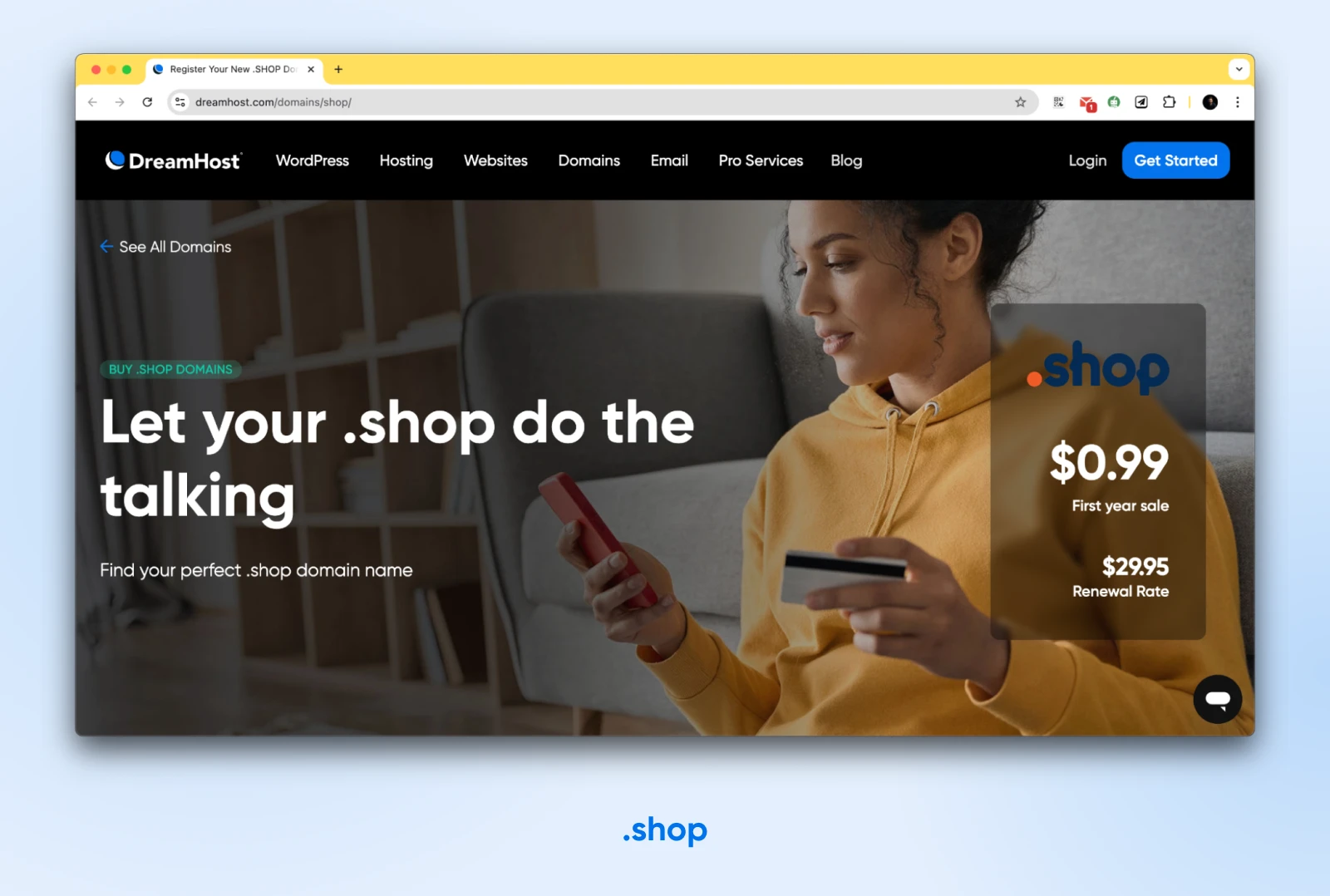
If you run an online store or are a small online retailer, .shop is an excellent domain extension.
It’s versatile, signals to visitors that you’re an online business, and may even serve as a call to action.
.shop is also easy to understand. It’s a somewhat universal term, with consumers from around the globe recognizing that you can use the site to purchase goods, products, or services.
.co
When most .com domains are taken, the .co domain turns out to be a great alternative — the country code for Colombia.
It works like a shortened version of .com. It’s flexible and suitable for companies of all types and sizes. This might be the next best option if your ideal .com is already taken.
.org

The .org extension is intended for non-profit organizations looking to promote their cause and make their site easy to find. Well-known examples include the Red Cross and the World Wildlife Fund. If you are a non-profit, pick a .org to establish instant credibility.
.io or .tech
For tech startups looking for a hip, modern vibe, .io (British Indian Ocean Territory) or .tech can be great options. They’re popular with software companies, apps, and tech giants like Intel and Cisco. They communicate that you’re a cutting-edge business.
.xyz
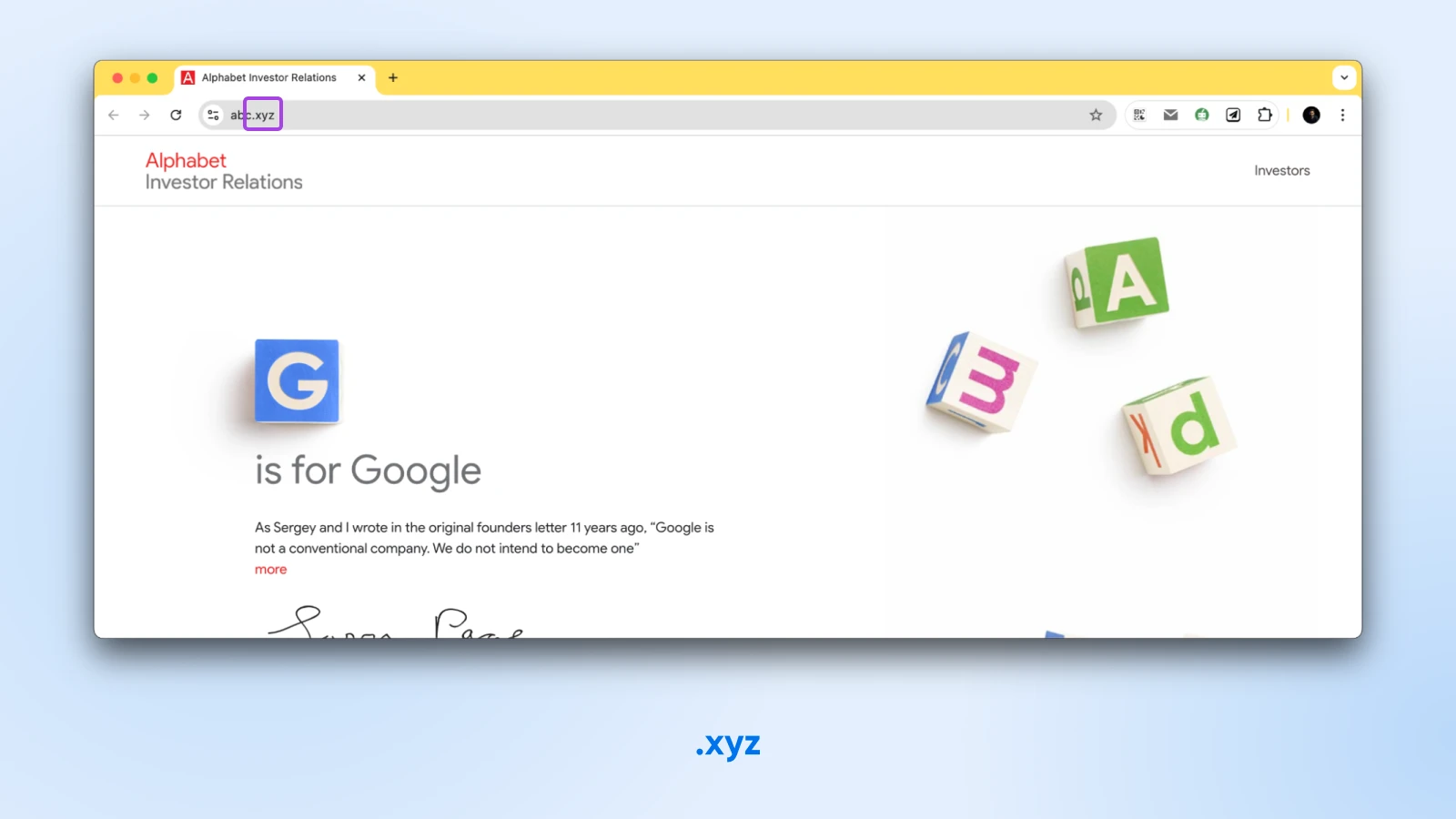
The .xyz domain extension has become one of the most successful new TLDs, used by large conglomerates like Google’s parent company Alphabet and Block. From our observation, it’s often ideal for hip startups.
.us, .ca, .eu, .au etc.
If you still can’t find the perfect domain with the domain extensions above, you can also go with country extensions.
Country-code extensions are a good choice if your business has strong ties to a geographic area. They’re more trusted and memorable than new niche extensions.
Apart from these, ICANN launched hundreds of domain extensions specific to business categories, like the following ones:
- E-commerce businesses: .shop, .store .shopping
- Tech companies and apps: .tech, .app, .digital, .io, .it
- Legal practices: .law, .legal, .attorney
- Business services: .marketing, .consulting, .solutions
- Beauty industry businesses: .beauty, .hair, .makeup
- Photographers and artists: .photography, .photos, .photo, .gallery
- Investment and VC firms: .ventures, .capital, .fund
- Real estate industry: .properties, .land
- News and publishing businesses: .media, .news, .press
- Food service businesses: .restaurant, .catering
The main benefit of these niche extensions is that they clearly communicate what your business does at a glance.
Instead of JoesRepairShop.com, you could use JoesRepair.shop or even just Joes.repair.
The only downside is that people aren’t used to seeing these extensions. Does that mean you should disregard them altogether? Not at all.
You may need to do extra marketing for them if you’re an early adopter of these extensions. However, once these become common, those drawbacks should diminish.
Avoid Meme and Obscure TLDs
There are hundreds of new niche domain extensions available today, like .space, .fun, .ninja, .luxury, etc. While one of these can be a playful, memorable choice, it’s usually best for small businesses to steer clear.
The main problem with obscure TLDs is that most people still aren’t very familiar with them. So if you tell someone your domain is YourBusiness.ninja, they’re not going to subconsciously register your business name unless, of course, you deal in products related to ninjas.
These TLDs can also look gimmicky or amateurish, undermining your company’s credibility. They’re better suited for blogs, side projects, and personal sites than for professional companies trying to establish authority in their industry. That’s also why you won’t see many big corporate sites using them yet.
Simply put, don’t make it hard for people to find you online.
The exception might be if you find an obscure TLD that’s a perfect, super memorable fit for your brand voice.
For example, a trendy coffee shop could pull off a domain like JoesBrews.coffee, or a jewelry store could use JanesBling.jewelry. That said, for most small businesses, it’s wiser to stick to the more common, trusted options.
3 Tips for Choosing Your Domain Name Extension
Choosing a domain name for your business is a big deal, so it’s important to give it a lot of thought and consideration. To help you with this, we’ve compiled a list of tips for choosing the perfect domain.
1. Explore All Options To Find the Perfect Domain
One common mistake people make when choosing a domain extension is assuming that all .com domains are available. This is not always the case.
In fact, most .com domains have already been registered. If you’re having trouble finding an available .com domain, you do have some options in domain aftermarkets or hiring a domain broker to help find and facilitate a domain transaction. These are places where you can also sell your domains after you have determined a value.
However, if you cannot make any headway here, using a different extension is a strong secondary option.
For instance, you could try your business’s domain name with the .online extension. You can also get more granular than that. For example, if you’re an online retailer, you could try .shop.
2. Choose an Extension That Suits Your Website’s Content
Another mistake is choosing a domain extension that doesn’t match your website’s content. For example, if you’re creating a website about travel, .travel would be a good fit.
Choosing an extension that accurately represents your website’s content helps avoid confusion so people can find what they’re looking for.
We recommend considering your website’s purpose and audience. This will help you narrow down your options and choose an extension relevant to your content.
3. Make Sure Your Domain Name Is Memorable
Some people choose domain extensions that are too long or difficult to remember.
While you want an extension that represents your company and its services, you also want one that’s memorable.
The same is true for ensuring your domain is easy to say aloud. If someone wants to give out your domain while having a conversation, it should be shareable.
How to Search for Domain Extensions
Before registering your domain name and extension, make sure it’s available for purchase.
For example, suppose you’re registering a .com domain. In that case, you can only register a name that has not already been taken.
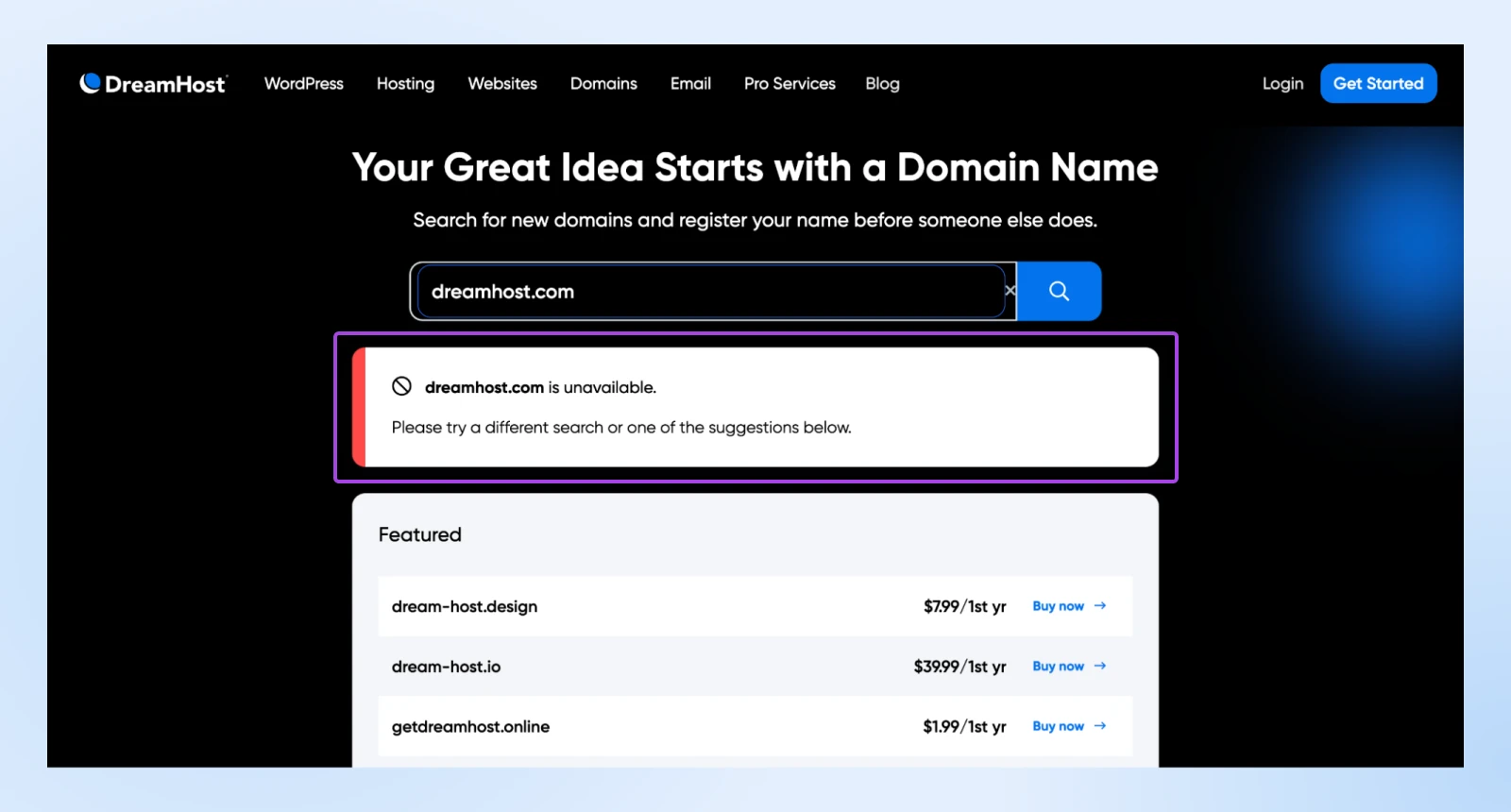
You can purchase a domain name and extension from various places, including domain registrars like DreamHost.
The important factors with domain registrars are:
- Trustworthiness of the registrar
- Any first-year promotions
- What are their annual renewal prices after the first year?
Ask yourself, How long has this registrar been in business? Do they have good reviews?
A domain registrar’s location is also important due to political territory and privacy restrictions, as many countries ban using certain domain keywords in other countries (China, Russia).
More recently, some registrars have also started to ban users registering virus-related domains during the COVID-19 pandemic.
A Trusted Domain Registrar for Over 25 Years
Many web hosting companies provide domains as part of their hosting packages.
At DreamHost, when you register a domain name, you also get free WHOIS privacy protection on select domains.
To check if a domain name is available on DreamHost, you can use our Domain Name Search tool. Simply enter the domain name you want to register, and we’ll let you know if it’s available.
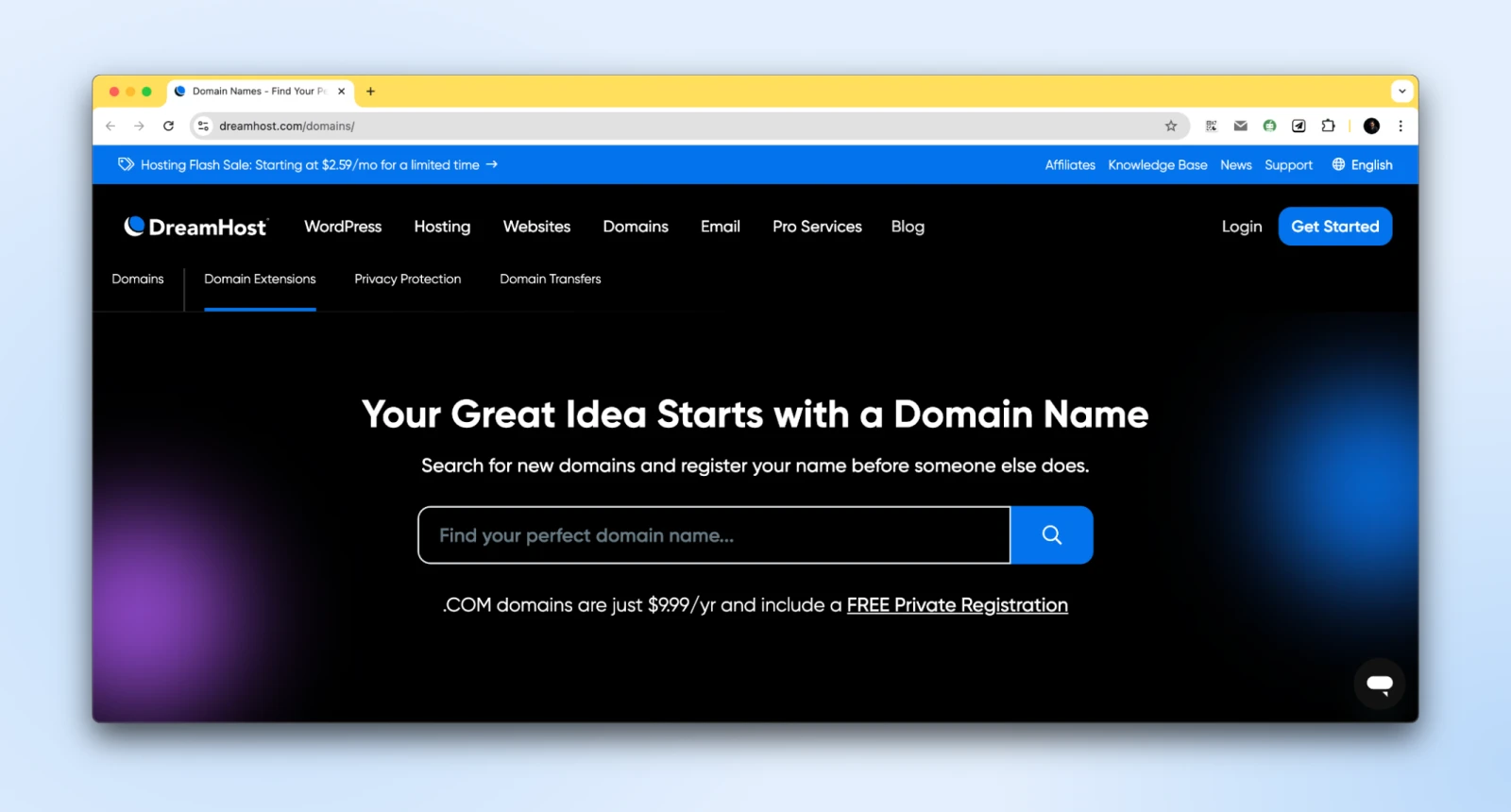
If the domain name is available, you can add it to your cart and begin registration.
However, if the domain name is already registered, you’ll need to choose a different one for your website.
In most cases, you can pay for your domain yearly.
Once your payment is processed, your domain will be registered, and you can start building your website.
At DreamHost, we give you a free domain name when you purchase an annual web hosting plan. However, you can also buy a domain from DreamHost without having a hosting plan with us.
We offer competitive pricing on all our domains, so you can register the perfect domain name for your website without breaking the bank. You can also transfer your domain name to DreamHost if you’re unhappy with your current registrar.
Domain Extension FAQs
At this point, you have a strong grasp of domain name extensions. However, to ensure we’ve covered all the vital information, let’s wrap up with some FAQs.
How important is it to choose the right domain extension?
Choosing the right domain extension is essential for building a successful online presence. This extension can indicate your site’s content and increase your site’s credibility. By taking the time to research your options, you can set your website up for success.
Should you use a new TLD for your website?
The answer to this question depends on a few factors. First, you should consider your target audience. If they’re familiar with the internet, using a new domain name extension shouldn’t be a problem.
However, if your target audience is less internet-savvy, they may have difficulty remembering or finding your website if you use a new TLD.
Also, consider your budget when deciding whether or not to use a new TLD. New TLDs can be more expensive than traditional ones, so weigh the cost against the potential benefits.
Can I create my own domain name extension?
Yes, you can create your own domain extension, but the process isn’t simple or cheap. You’ll need to work with ICANN, the organization that oversees the DNS, to get your new TLD approved. The approval process can take up to two years, and it’s not guaranteed that you will get your desired TLD.
If you’d like to create a domain extension, we recommend working with an experienced domain name registrar who can guide you through the process. This partnership can take some of the hassle out of the registration.
What is the most popular domain extension?
The most popular domain extension is .com, but many other options are available. You can choose from over 1,500 different domain extensions.
If you’re unsure which domain extension to choose, we recommend starting with a .com domain. If you’re looking for something more unique or specific, there are plenty of other options for more niche sites.
Can you change your domain name extension?
Yes, you can change your domain name extension. However, it’s important to choose the right extension for your website from the start. Once you’ve chosen an extension, changing it can be difficult and expensive.
If you’re unsure which domain extension to choose, we recommend doing some research. Once you’ve found the perfect extension, register it as soon as possible to avoid any potential problems.
How much does a domain extension cost?
Domain name prices vary depending on the extension you choose. Some domain extensions, like .com and .net, are less expensive than others, like .biz and .info.
You can typically expect to pay around $10–15 per year for a basic domain name. However, prices may vary depending on the registrar you choose.
To get an accurate estimate of what a domain name will cost you, check with your chosen registrar.
What is WHOIS privacy protection?
WHOIS privacy protection is a service that hides your personal information from public view. This feature is important because when you register a domain name, your personal information (such as your name, address, and email address) is made available to anyone who looks it up.
With domain privacy protection, your information is hidden from public view, keeping you safe from spam and identity theft.
DreamHost offers WHOIS privacy protection on select domains. If you want to keep your personal information safe and secure, choose a domain with this service.
Ready to Register Your Perfect Domain?
As you can see, a lot goes into choosing the perfect domain extension for your small business website. However, with the tips and best practices outlined in this guide, you can find an option that serves your business well.
If you can’t get a website with a .com domain extension, look into popular alternatives like .co, .net, or country-specific extensions to maintain credibility and recognition.
And if you are marketing yourself as a hip, modern-day business, it makes sense for you to try out the new TLDs as well. Nonetheless, the most important thing is to get that perfect domain locked down before someone else does.
Because while you can always change your website design, your logo, and even your prices, your domain will be the one constant that carries your brand for years to come. It’s the online identity you’ll use to build customer recognition and SEO authority.
So don’t let analysis paralysis hold you back. Once you’ve found an available domain that checks all the boxes, it’s time to make it yours. If you buy multiple variations, set them up to redirect to your primary domain.
Need a great deal on domain registration and reliable hosting for your new website? Try DreamHost — your one-stop solution.
DreamHost’s domain search tool helps you find your perfect domain across a large variety of domain extensions without having to go through different websites.
So go out there and give it a shot today!

Your Great Idea Starts with a Domain Name
Don’t let someone else register your URL. Search DreamHost’s 400+ TLDs to find the perfect fit for your website.
Master Your DomainThe post The Domain Extension Guide: Why They Matter and How To Choose One for Your Business appeared first on DreamHost Blog.
]]>The post What’s In A Name? How To Assess Domain Name Value appeared first on DreamHost Blog.
]]>Sellers don’t want to sell something valuable for less than it’s worth.
Buyers, of course, don’t want to get ripped off.
But why is it so difficult to just figure out the monetary value of a domain?
The transactions often happen anonymously via private sales channels, there’s no cut-and-dry standard for pricing, and the valuations are certainly more complex than the market rate for a pound of lobster.
That complexity in the domain valuation formula is exactly what we’ll get into today. We’ll look at all the relevant factors that influence the domain cost, including market trends, keyword popularity, domain length, domain extension, as well as branding potential, and memorability.
We’ll also examine some tools and services that can help you appraise domain names and conduct transactions.
Related reading: 12 Tips For Choosing The Perfect Domain Name For Your Website
Whether you’re a domain owner, domain investor, digital marketer, or business owner, this guide will break down everything you need to know about domain name value.
The Anatomy Of A Domain
Domain Name
Domain names are like an address for the internet, making it easier to find websites without having to remember a complex string of numbers. They’re also helpful in distinguishing one website from another because each domain name must be unique.
Read MoreBefore getting into valuable domains, we must look closely at exactly what we’re trying to find the value of a domain.
A domain name is a human-readable web address used to identify a specific location on the internet. It serves as a way for users to remember and access websites easily. Domain names are part of the Domain Name System (DNS), a hierarchical system that translates easily memorable names, like www.example.com, into numerical IP addresses that computers use to identify each other on the internet.
Important: A domain is not the same as a URL.
A URL (Uniform Resource Locator) is a more complete web address that specifies the protocol used to access a resource, the domain where the resource is located, and the path to the specific resource on the server.
For example: https://www.example.com/blog/blog-post-title
OK, back to domains…
A domain name consists of two primary components:
- Second-Level Domain (SLD): This refers to the main part of the URL, which most commonly contains the name of the website or the business that owns it. In our example, this is “example.”
- Top-Level Domain (TLD): This is what comes at the end of the domain name, which in our case is .com. Hundreds of TLDs are available, but some of the most popular include .com, .net, .org, .gov, and .edu.
Each of these components plays a role in the valuation.
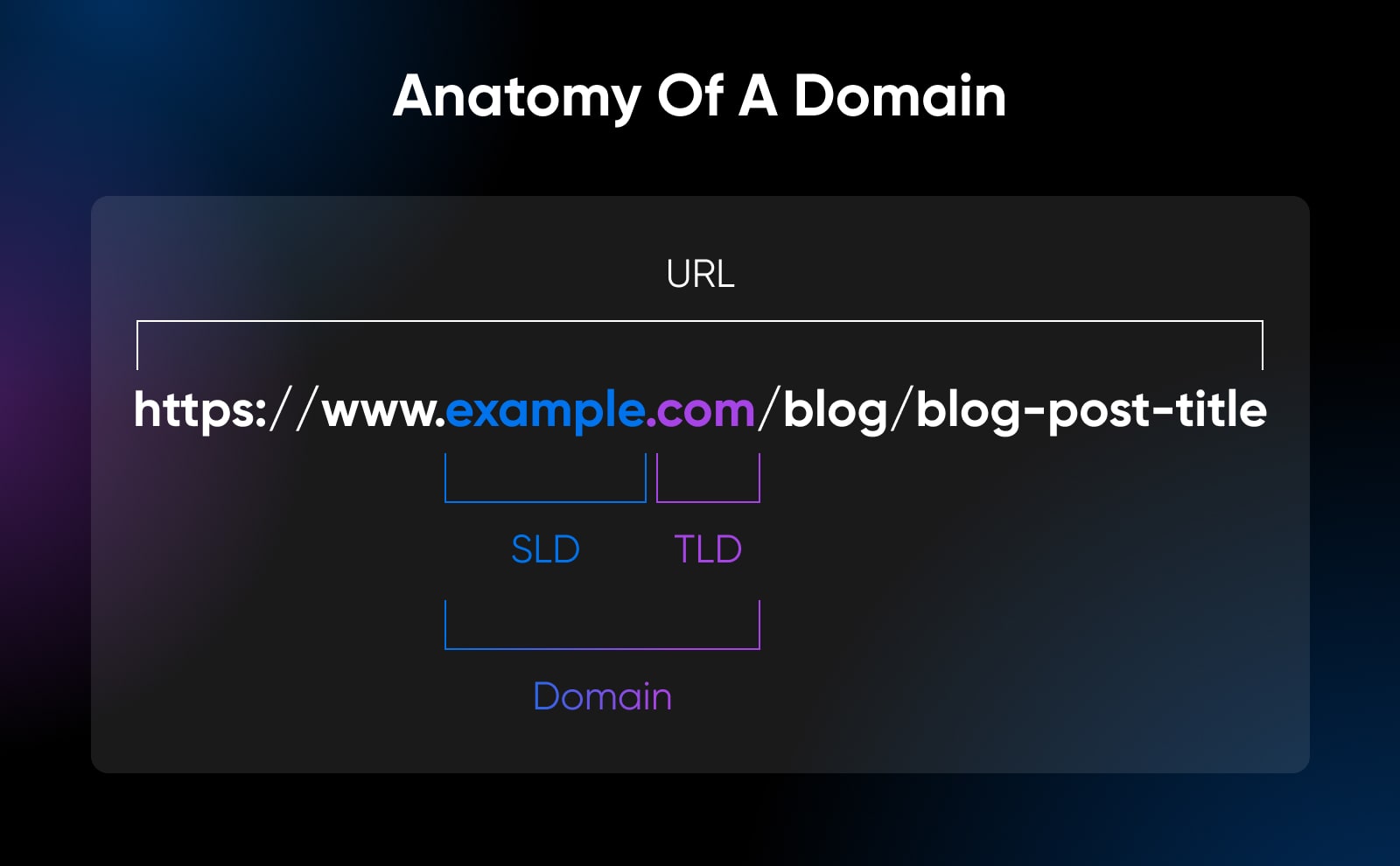
The Factors That Influence Domain Value
Now that you understand the nuts and bolts of a domain, let’s zoom in and discover how various factors might influence the price of a domain for sale.
As mentioned earlier, there are no cut-and-dry domain valuation criteria. The domain market and the negotiation between prospective buyers and sellers will ultimately decide the price, but the factors below are ranked in order of significance.
Length And Simplicity
Generally speaking, the shorter a domain, the more it’s worth. This is particularly true if it’s a single word. This isn’t always the case; brevity alone doesn’t make an otherwise cumbersome domain like zz0xy2c.org more appealing to potential buyers. This is because shorter domains are more memorable, easier to share, and more marketable.
Additionally, we are running out of new single-word domains, so their scarcity makes them more valuable.
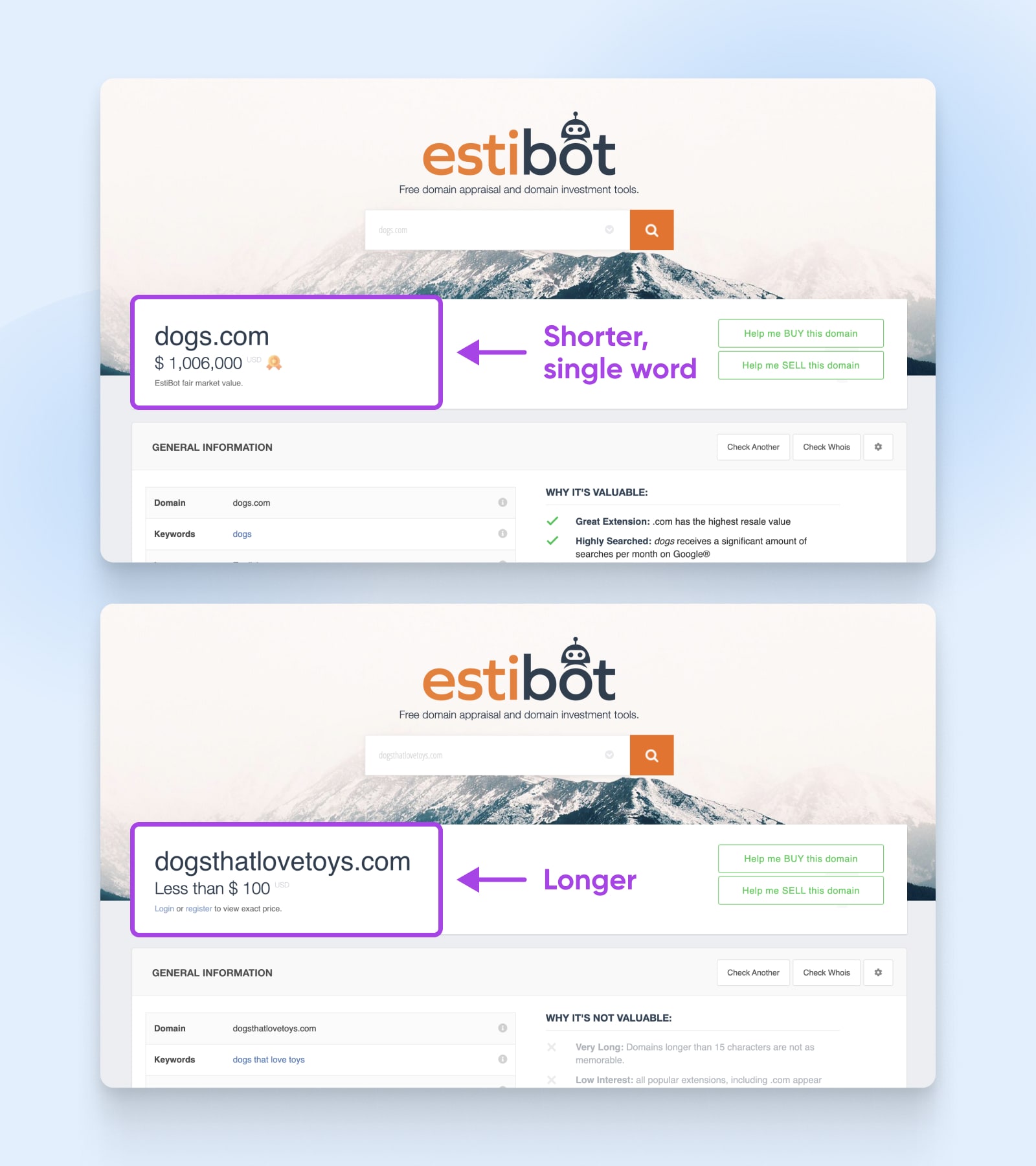
Common Top-Level Domain
A domain’s TLD can be a big part of what makes it desirable. For example, .com remains the most popular option, so many buyers will pay a premium for it. For the foreseeable future, a domain like example.com will cost more than example.xyz.
Brand Potential
While a domain’s brand potential can be difficult to define, it’s also an important consideration many site owners make when choosing a name. Entrepreneurs who start a business want to have a domain name that represents their brand (which could increase their advertising effectiveness) and they’re willing to pay thousands of dollars for them or more, in some cases.
OpenAI bought ai.com for $11 million in 2023.
[bng]
Keywords
Including relevant keywords in your domain name can provide search engine optimization (SEO) benefits. According to a study by Higher Visibility, in most industries, a majority of sites include valuable keywords in their domains. Keywords with inherently high search volume will generally command higher prices.
For example, the top-rated website for the search engine query “hotel” is www.hotels.com. As such, if your domain contains a desirable keyword, this could increase its value.
Related reading: The Top 11 SEO Best Practices for Domains
Spelling
This may seem obvious, but domains with proper spelling are more valuable than those without. Large brands, however, might even buy the domains of common misspellings and redirect them to the official site.
Depending on your brand, however, using unexpected spelling can sometimes be a benefit, as it could make the domain more brandable. For example, fiverr.com and tumblr.com have used technically incorrect spellings to create memorable, lasting brands.
Extension Trends
Certain TLDs may gain popularity due to trends or industry-specific preferences. For example, .io has become popular for business startups; it almost carries a connotation of innovation by itself.
However, .ai has become popular for many businesses in the tech industry as artificial intelligence becomes more commonplace. In fact, usage of .ai has increased over 100% in the last year.
Monitoring extension trends can provide insights into the potential value of a domain.
Existing Traffic
Lastly, a different scenario happens if the domain is already directing traffic to a live website, thereby accumulating traffic. If the domain has an existing audience attached, the buyer can immediately leverage that traffic for their site. The domain age can also help its SEO for the new owner, which may make it even more appealing.
Again, remember that there are no guarantees in the game of domain name valuation. We provide these valuable insights as a general guideline and something to help you make an informed decision when it’s time to buy or sell an actual domain.
Now that you know the basics, let’s outline a process to assess a fair market estimate for your domain (or one you’d like to purchase).
Steps To Determine The Value Of A Domain Name
The art of domain valuation is highly nuanced, as we covered earlier, but there is a detailed analysis and well-defined process you can use to make strategic decisions.
Let’s get started.
Step 1: Research The Purchase History Of Similar Domains
To figure out what people may be willing to pay for your domain name, you need to know what people are charging for similar domains. We mentioned earlier that the value of a given domain can shift dramatically over time, so you probably can’t use what you initially paid for the domain as a baseline.
DN Journal is one of the best places to start this research type.
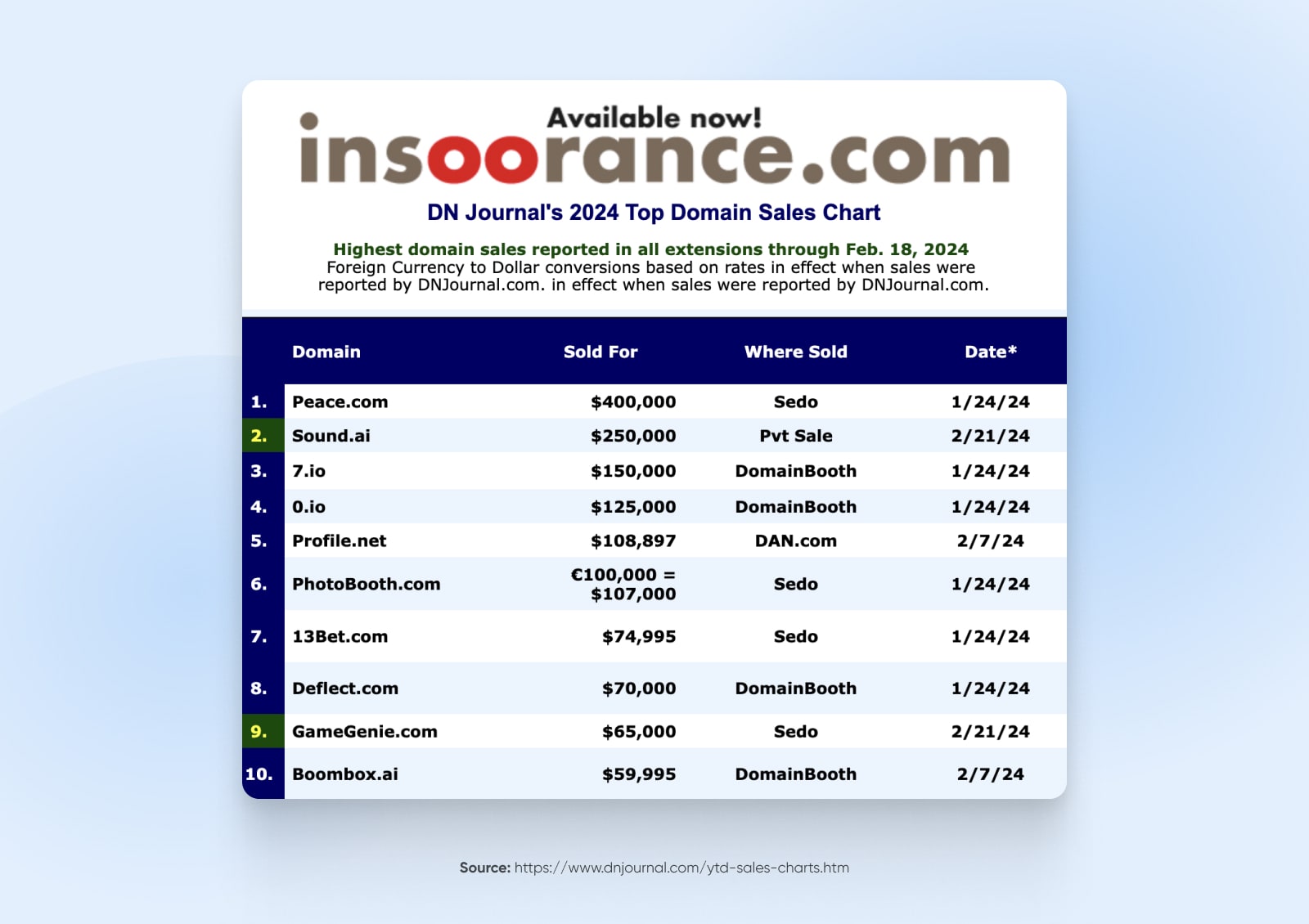
Does it have the worst web design on the internet? Probably. But it’s also one of the most reliable historical domain sales and analysis sources. DN Journal can tell you about the past three weeks’ highest reported sales and also offers some invaluable insights into the domain marketplace in general.
DN Journal updates on a weekly basis — If you want something even more up-to-date, try NameBio, which offers a Live Feed, where you can see domain name sales as they happen. Additionally, an account will allow you to try out “The Domain Game”, where you can guess the price range of real domain sales.
Another site with a similar purpose is Domain Name Wire. You can find regular roundups of prominent, recent domain sales on the blog.
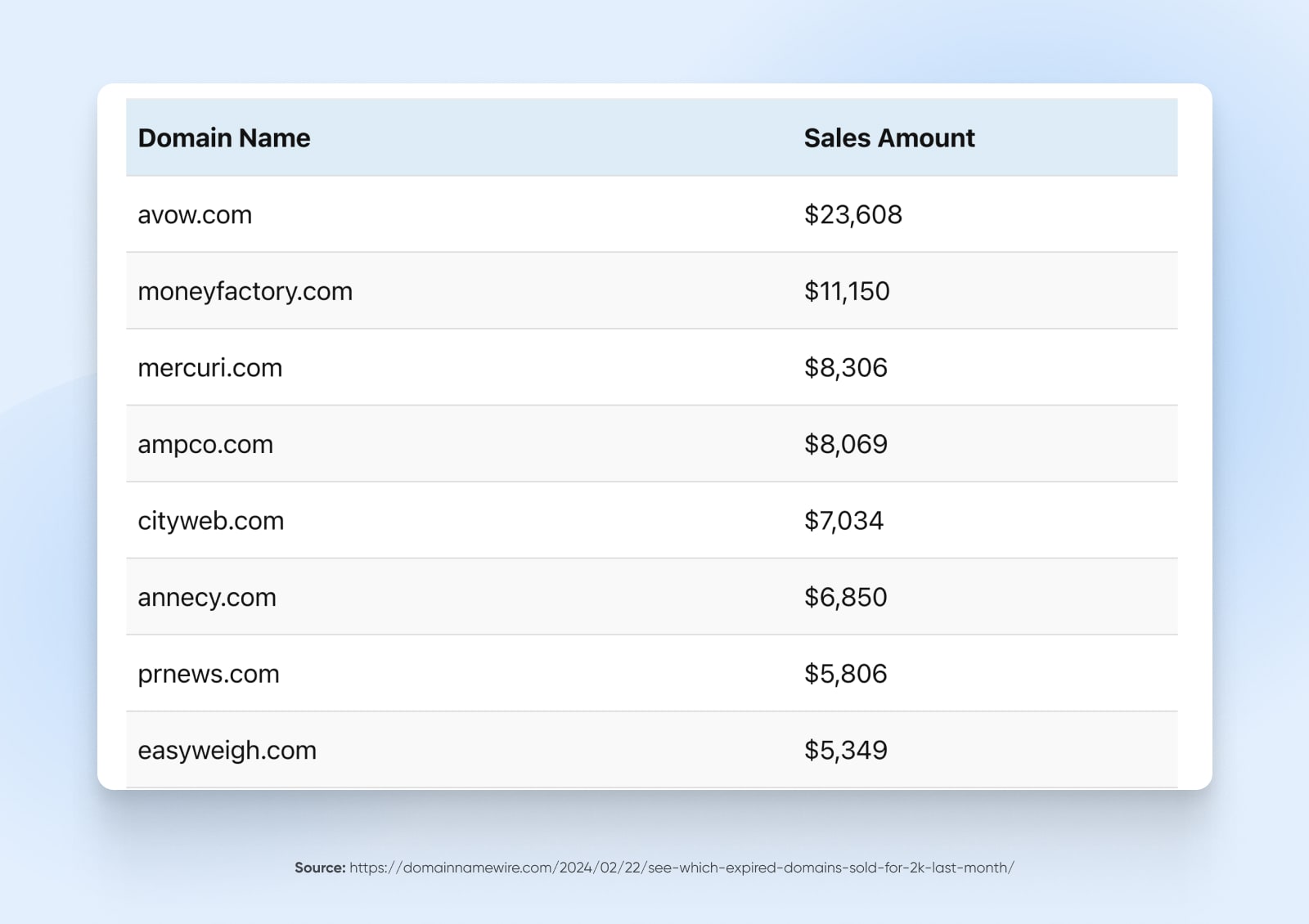
If your domain is concise, you may find ShortNames especially useful. This site also collects recent sales, but specializes in (you guessed it) short domain names.
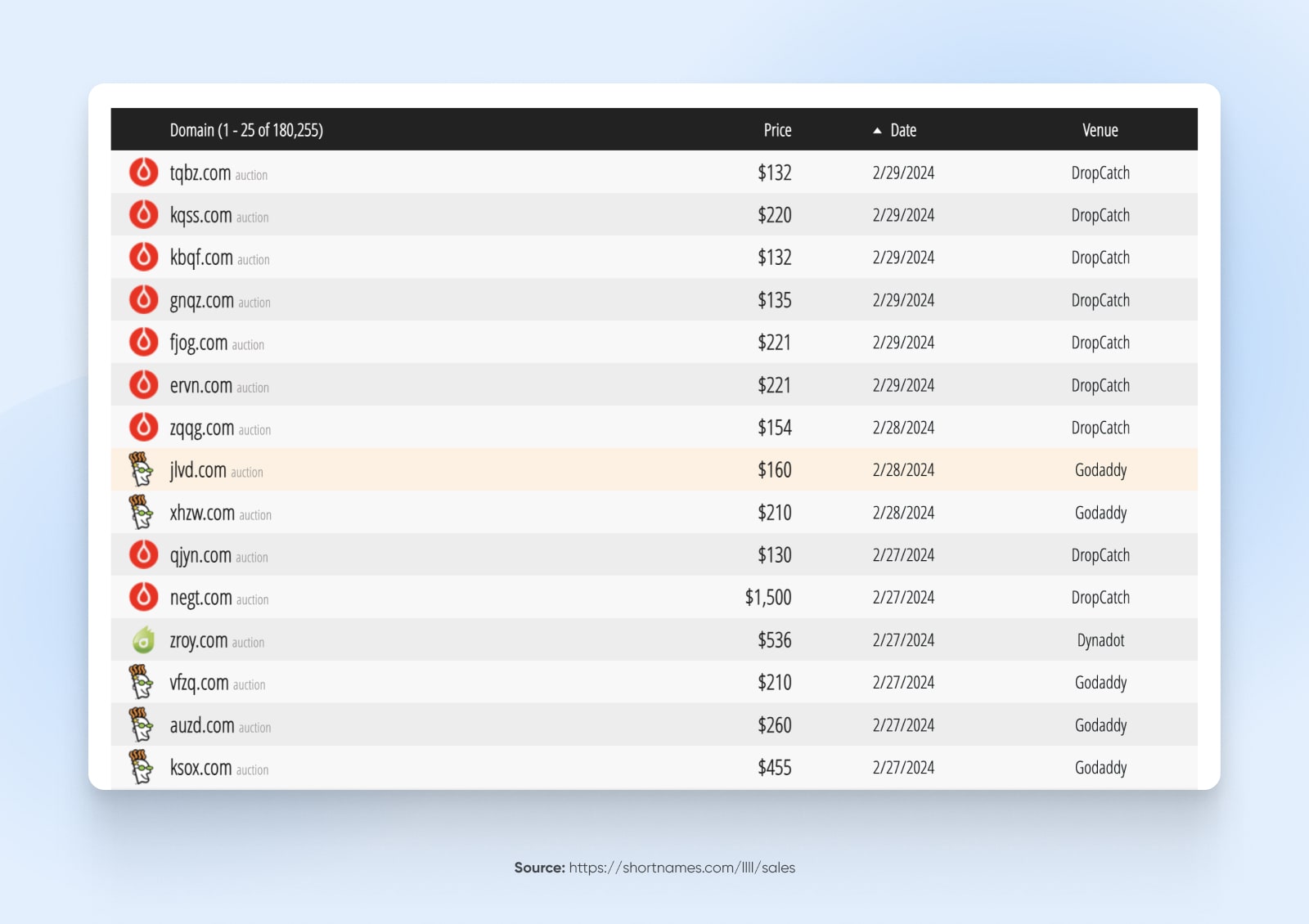
Additionally, you look into other TLDs. DotDB allows you to check how many TLDs have been registered worldwide and what kinds of TLDs have been registered.
For many people, this first step (paired with common sense and shrewd negotiating skills) will give you a reasonable estimate to assess the value of a domain. However, if you want to find information about sales for more directly comparable domains, you will need to dig a little deeper.
Step 2: Use A Domain Name Appraisal Service
A domain appraisal service is a website that enables you to find information about your domain, helping you estimate its value and compare it to similar names.
These services offer domain analysis, compare your domain against similar names, and collect information about what those other domains sold for. It will also measure your domain’s worth, based on many of the factors we outlined previously. If you’re serious about putting an estimated price on your domain, this is one of the easiest methods for getting an educated answer.
You can use many appraisal sites, and some of the largest domain registrars might even have their own built-in service for this.
One of the options for domain valuations is GoDaddy. GoDaddy estimates the price of domains by comparing the length, the TLD, and whether the domain contains common words. You can also view similar domains to see how much they sold for.
If you’re searching for just one or two domain names, you might consider EstiBot. EstiBot is the most widely used domain appraisal tool, and uses an exclusive algorithm to combine keyword data about the domain with historical domain name sales to provide a super detailed report showing how it arrived at the valuations. However, EstiBot allows a limited number of searches before reminding you to check out their subscription plans, or create an account.
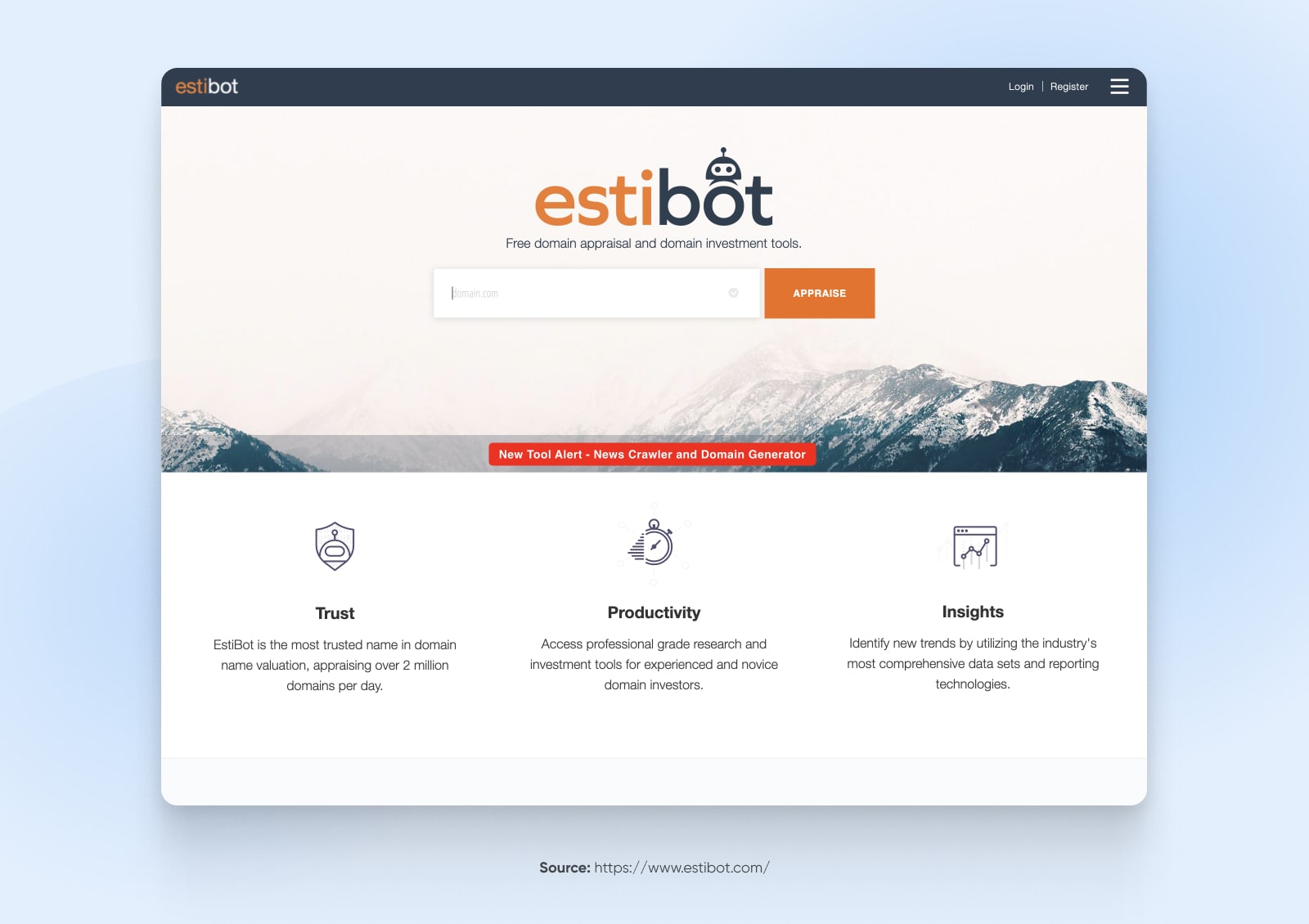
You can view a huge amount of statistics and analytics for the domain, giving you an even clearer picture of its ultimate worth.
Estibot offers a suite of tools beyond its domain value calculator that help investors manage their entire domain portfolios.
This should provide you with a substantial theoretical value for your domain. However, as we’ve already mentioned, a domain’s real value is what someone is actually willing to pay for it. As such, if you want a definite answer, you may need to go straight to your potential buyers.
Step 3: Find Out What People Are Willing to Pay for Your Domain Name
Taking the time to do research and use estimation tools will undoubtedly be useful. Sometimes, you might have to go straight to potential buyers for a definitive answer.
For instance, a domain could theoretically tick many of the boxes we outlined earlier, but still not be one that actually sells. It could be that the domain simply isn’t relevant to anyone, is too similar to an existing prominent site, or has an unfortunate connotation that makes it less desirable.
On the flip side, the opposite could also be true. A domain that shouldn’t be particularly valuable might be just what a particular website owner is looking for. This can make it even more lucrative than anticipated.
The best way to find these things out is by putting the domain name up for sale and seeing what price it fetches. Many domain broker services enable you to buy and sell domains and will also let you set a reserve price for them, similar to how eBay works.
Examples of these services include Flippa, or Squadhelp— Both are online marketplaces for domains. Note that Flippa is a paid service, but their nominal fee might be totally worth it if you think your domain is worth hundreds or even thousands of dollars.
Both sites function as an auction, so you can sit back and watch as the bids roll in, giving an accurate estimate of your domain’s value to real people. If you’re lucky, somebody will take a fancy to your domain and may even bid above the reserve right away. Either way, at the end of this process, you should have a clearer idea of how much your domain name is worth.
Next Steps
If you’re ready to get started in the domain business, we can help! DreamHost specializes in domains by providing an easy interface to search for, purchase, and manage your assets.
If you need website hosting to go along with your domain and sign up with us, we’ll even give you the domain for free!
We hope you found this guide helpful, but more importantly, we hope you do something with it. Whether that’s finding the perfect domain for your website or business or beginning your career as a domain investor.
Get started by browsing all types of domains here!

Your Great Idea Starts with a Domain Name
Don’t let someone else register your URL. Search DreamHost’s 400+ TLDs to find the perfect fit for your website.
The post What’s In A Name? How To Assess Domain Name Value appeared first on DreamHost Blog.
]]>The post Nameservers Vs. DNS: A Complete Guide appeared first on DreamHost Blog.
]]>This is why it’s important to understand what nameservers and the Domain Name System (DNS) are and how they work. This knowledge will help you manage your migration efficiently and keep the traffic flowing.
In this post, we’ll look closer at nameservers and DNS records. We’ll also show you how you can access these essential components of your site. Let’s get started!
Nameserver
A nameserver is the Domain Name System (DNS) server component that translates a website’s domain name into a numerical IP address. This term can refer to any server with DNS software, as well as a hosting provider’s server that manages customer domain names.
Read MoreNameservers Vs. DNS Records: What They Are And How They Work
A nameserver connects your domain name with the server’s Internet Protocol (IP) address that hosts your website. Thanks to nameservers, browsers like Google Chrome and Mozilla Firefox can direct users to the right page when they type in a site address.
For example, if you type example.com into Google, the nameserver tells the browser where that domain is located (i.e., the address of your web host). Without this information, the browser couldn’t display the site.
Nameservers form a part of an online database known as the Domain Name System (DNS).
DNS
The Domain Name System (DNS) protocol keeps records of which domain names correspond to specific IP addresses. DNS enables you to browse the web by typing in regular URLs instead of IP addresses.
Read MoreThis system works in partnership with the Transmission Control Protocol (TCP) and the Internet Protocol (IP), which define how computers communicate via the Internet and private networks.
DNS plays an important role in converting simple domain names (e.g., example.com) into an IP address (e.g., 12.34.56.78), which computers then use to identify one another on the network.
Essentially, think of DNS as a phone directory. It contains records of web devices, such as computers and servers, and their associated IP addresses.
Every domain has its own DNS records, which include the nameserver. These are generated when you register your domain name with a hosting provider or a domain registrar. Therefore, your nameserver points your domain name to the IP address of your host or registrar.

How The Browser Finds Your Website
Everything that’s connected to the internet has an IP address, including websites and servers. There are millions of IPs in use all over the world, and they’re all unique. Your site will have its own IP address, which your host provides.
Your domain name must, however, be able to connect to the IP address of your site. For example, when you enter a site’s URL into an address bar, your browser will try to access the corresponding page. To do this, it’ll go through some steps that you won’t see.
First, the browser connects to the target site’s domain registrar and asks for directions. This is called a DNS query. Then, the registrar points the browser to the target site’s hosting provider (e.g., dreamhost.com). Once the browser arrives at the web host, it’ll look for the correct nameserver (e.g., ns1.dreamhost.com).
This whole process is instantaneous.
As users, we don’t fully appreciate the additional steps. However, if you decide to change hosting providers, you’ll need to update your domain name records to point to the new host. This is a vital step. Otherwise, users won’t be able to find or access your site.
How To Use Nameservers And DNS Records
Accessing the DNS records, including your nameservers, can make the process much easier when transferring your domain. Let’s take a look at the different ways you can locate and manage these important records.
Locating And Managing Your Nameservers
Your domain’s nameservers can be found in your web hosting account. These might also be available on the hosting company’s documentation page.
The nameservers for domains managed by DreamHost are:
- ns1.dreamhost.com
- ns2.dreamhost.com
- ns3.dreamhost.com
If you’re a DreamHost client, you can log in to your hosting account to view your nameservers.
Note that if your domain is registered with a different company, you won’t be able to update your nameservers from your DreamHost account. To manage your nameservers, you’ll need to log in to your account with the company that manages your domain.
If your domain is registered with DreamHost, you’ll be able to edit your nameservers. For instance, if you want to replace your current nameservers, you can simply erase them from the box and type in your new ones.
You can also manage your domain from the Registrations page in your account. For more information about this, you can read our complete instructions for editing your nameservers on DreamHost.
Alternatively, you can find out what a website’s nameservers are by performing a WHOIS lookup. Nameservers are public records, so it’s possible to find this information by using a third-party tool.
Several sites offer this service, including ICANN’s lookup tool.
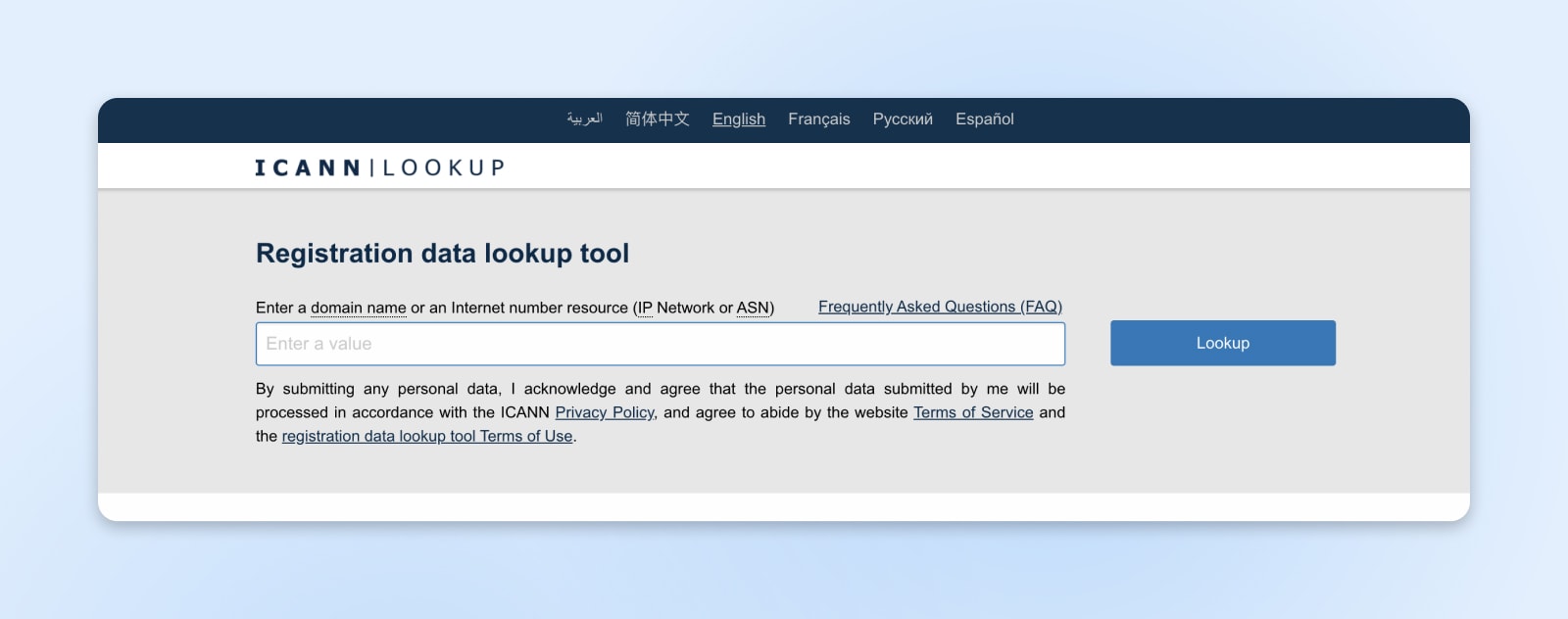
You can type the domain name into the search bar, and a list of records will appear. For example, here are the nameservers for google.com:
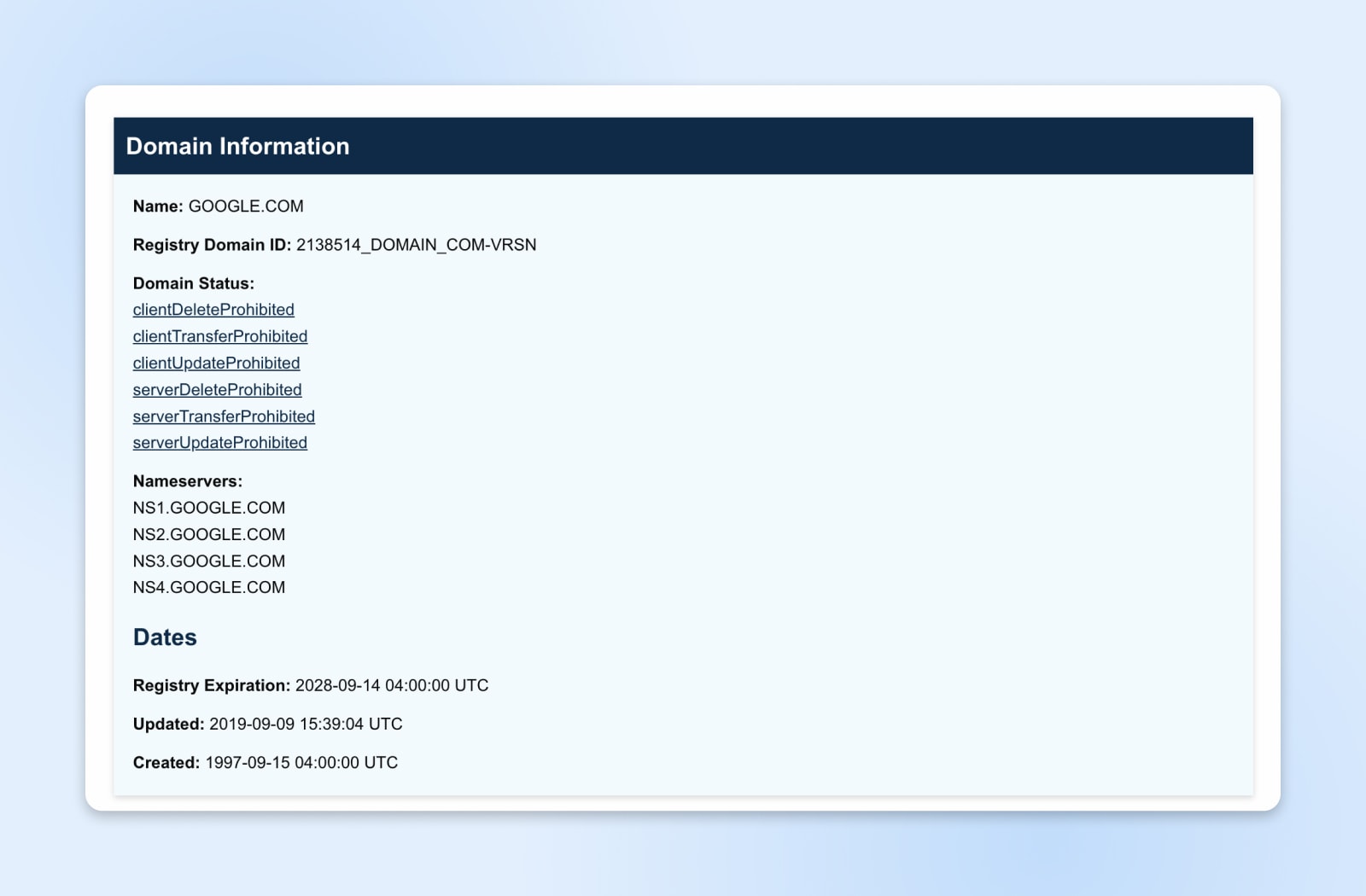
Note that a WHOIS search can also show the personal details of the domain’s owner, including their name and email address. Some hosting providers and domain registrars offer WHOIS privacy, which protects the user’s identity.
Locating And Managing Your DNS Records
Your DNS records are just as easy to locate and manage. You can log in to your hosting account to view your records and change them. If your domain is managed by a third party, such as a domain name registrar, you’ll need to log in to your account with that company.
If you have a DreamHost account, your DNS records can be found on the same page as your nameservers.
You can add a new DNS record to your domain by following these instructions. You’ll notice there are different types of records you can create. Let’s take a closer look at the most common ones.
A Record
The address record is the most basic type of DNS record. It points a domain (or subdomain) to an IP address.
Subdomain
A subdomain is an additional element added to the start of a website’s domain name. In blog.example.com, “blog.” is the subdomain. Subdomains are usually added to domains to create new pages that have unique content and/or functionality that extend the reach and purpose of a website.
Read MoreCNAME Record
The canonical name record points a domain to another domain instead of an IP address. This is used when a site has subdomains, such as shop.myblog.com or donations.example.myblog.com.
These are subdomains of myblog.com. Let’s say that each of these subdomains has a CNAME record containing the value myblog.com. Since the DNS is looking for an IP address when the CNAME record is accessed, a further lookup is carried out at myblog.com (as this is the value contained in the CNAME file).
CNAME Record
CNAME is an abbreviation of “Canonical Name”. This term is typical when referring to a “CNAME record” in a Domain Name System (DNS). It maps an alias domain to its true domain name.
Read MoreIt’ll then return the IP address stored in myblog.com’s “A” record. This means that these subdomains are aliases of the main domain, and the canonical name (or “true name”) of these subdomains is actually myblog.com.
MX Record
A mail exchange record is used to direct emails to an address registered on your domain (e.g., [email protected]) per the Simple Mail Transfer Protocol (SMTP) — the standard protocol for email.
Ensuring that your MX records point to the right mail server is important. Otherwise, you won’t receive emails through your account. Also, before switching hosts, we recommend backing up your emails.
NS Record
As mentioned previously, this is the nameserver record. You can use this setting to change your nameservers so that they point to your new hosting provider.
TXT (Text) Record
This one allows you to insert text into your DNS records. Originally, the TXT record was designed for human notes, such as site descriptions or development details. However, it’s possible to include machine-readable data.
This record can help you to protect your site against spam. It also enables you to verify your domain (e.g., by adding a Google Site Verification record). It’s quite common to have multiple TXT records for a single website.
Monitoring Your DNS Records
When updating your nameservers and other domain records, you’ll need to take DNS propagation into account. This is the time it takes for your DNS records to update across the internet. For example, when you modify your nameserver to point to your new hosting company, this change can take up to 72 hours to come into effect.
At DreamHost, we offer a DNS propagation checker to help you monitor your records. You can also use the propagation checker from ViewDNS.info or whatsmydns.net, which even has a map that shows your domain’s current IP address and DNS record information at multiple nameservers all over the world.
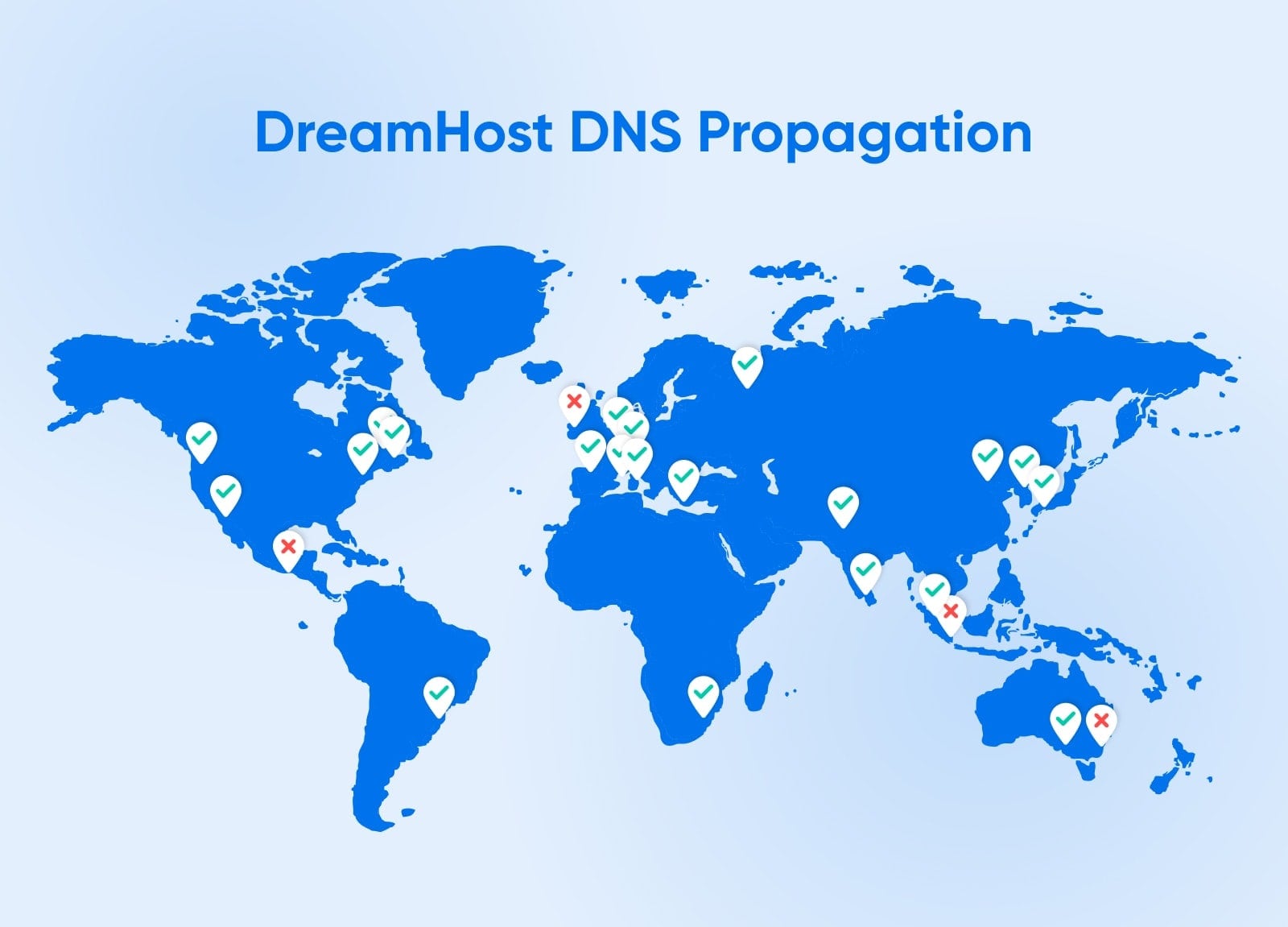
DNS And Nameserver FAQS
By now, you should have a pretty good understanding of how DNS and nameservers work. But there are a few more questions you should know the answers to. Let’s clear those up now:
What Is The Difference Between A DNS Zone And A Nameserver?
In simple terms, a DNS zone holds all the DNS records managed by a specific person or organization. It usually applies to one specific domain and related subdomains.
For example: if you own example.com, your DNS zone might include records for:
- www.example.com
- mail.example.com
- blog.example.com
In contrast, a nameserver is a server computer that hosts DNS zones. It stores all DNS records saved for your domain, and looks up the IP address when prompted.
What Is The Difference Between DNS Resolver And Nameserver?
A DNS resolver is a piece of software that initiates DNS queries whenever you try to access a website or internet resource by domain name. The resolver contacts nameservers and asks “What is the IP address for this domain name?”
The nameserver is the dedicated server computer that has the DNS records stored and which looks up the right IP address to send back to the resolver.
What Is TTL In DNS?
TTL stands for Time to Live. It’s a setting that tells resolvers and other computers how long to cache (temporarily store) a specific DNS record before requesting it again from the nameserver.
This helps reduce the number of queries whenever a domain is looked up, improving your site’s performance.
TTL is always set in seconds. You can choose anything between 30 seconds and 86,400 seconds (one whole day) or select automatic. In the latter case, records are refreshed automatically whenever they’re updated.
Nameservers Vs. DNS In A Nutshell
When you migrate your site to a new host, knowing how nameservers and DNS Records work can make the process a lot smoother. You need to make sure your domain points to the correct nameserver. Otherwise, site visitors will be unable to access your pages.
At DreamHost, we make your life easier by managing the entire transition process, including your domain transfers.
Plus, you can manage your own domains and DNS from your hosting account with us, and your domain also gets free privacy protection.

Private Domain Registration For All
Don’t let someone else register your domain first. Search DreamHost’s 400+ TLDs to find the perfect fit for your website.
Master Your DomainThe post Nameservers Vs. DNS: A Complete Guide appeared first on DreamHost Blog.
]]>The post 12 Tips For Choosing The Perfect Domain Name For Your Website appeared first on DreamHost Blog.
]]>The wrong domain name can make your site hard to find, negatively impact your brand’s reputation, or even give squatters opportunities to impersonate your website for nefarious activities.
So what’s the secret to avoiding all of that and choosing the perfect domain name? Fortunately, picking a winning domain isn’t overly complicated. As long as you do your research, stay on-brand, and keep it user-friendly, you’re likely to make a good choice.
Read on to learn more about the importance of choosing the right domain, and check out some of our top tips for choosing a domain name that uniquely and properly represents your website. Ready to learn more? Let’s get started!
Why Choosing The Perfect Domain Name Is Crucial
Domain Name
Domain names are like an address for the internet, making it easier to find websites without having to remember a complex string of numbers. They’re also helpful in distinguishing one website from another because each domain name must be unique.
Read MoreImagine if you had to navigate the web by typing long strings of numbers into the address bar in your web browser. You’d have to memorize lengthy sets of numbers for all your favorite websites. Or look them up. Getting around the ‘net would be much harder!
That’s why domain names were created. They’re a part of the larger Domain Name System (DNS), which allows internet users to input combinations of words into the address bar to navigate the internet instead of lengthy and exhausting strings of numbers. Your domain name acts as your web address: the unique word or phrase visitors will type in an address bar to visit your site.
In this sense, domain names serve a highly practical function, but they’re more than that. Your domain name is also often the first impression a potential customer will have of your brand, whether you’re a freelance photographer, a small business, or an international corporation. That’s why it’s so important to choose the right domain. It’s as important a part of your company’s branding as your name or logo.
It’s also important to follow some best practices when choosing a domain name. You don’t want it to be too long. Many people see that as spammy and a red flag. You also want it to be something catchy and memorable so people can easily recall it when they want to revisit your site.
Also note that changing your domain name can be challenging. It’s not impossible, but it can lead to some less-than-desirable outcomes like lost traffic and site downtime. That’s why it’s best to nail your domain name from the get-go so you don’t need to worry about changing it later.
How To Choose The Perfect Domain Name (12 Pro Tips)
Now that you know why picking the right domain name is so essential, let’s go over some key tips to help you do just that. The 12 pro tips below will help you choose the best domain name for your website or business. Once we’ve covered those, we’ll go over how to choose a domain name registrar and get your site built. Read on!
1. Stay Unique And On Brand
A unique domain name doesn’t just help your website stand out — it boosts your marketing and helps build your brand. However, you can’t just start with a great domain name. First, you need a great business name.
That’s where our free Business Name Generator comes in. You provide your industry and a few keywords, and the generator uses AI to provide a list of unique and memorable potential business names that will help you stand out from the competition.

Once you’ve chosen a perfect business name, the rest of these tips will help you make sure you pick an equally perfect domain name for it.
2. Choose Your Top-Level Domain Extension Carefully
A Top-Level Domain (TLD) extension is the last part of your URL: the suffix that comes right after your website name. Some of the most popular TLDs are .com, .org, and .net.
Among all the TLDs, .com is probably the most popular choice. However, if the .com domain name you want is already taken, it’s not the end of the world.
Other TLDs such as .xyz, .shop, .club, .online, .art, .inc, and even .party are becoming increasingly common. You can go with something relevant to your industry – like .biz or .shop if you’re in e-commerce, or even .marketing or .technology if you want to be specific about what you offer. Country codes, or ccTLDs, are also popular. In recent years, more and more startups are using ccTLDs like .co.uk (England), .io (Indian Ocean), .ai (Anguilla), and .co (Colombia), for example.
If you’re using our Business Name Generator to search for business names, you can click on any available name options to see a list of available domains and TLDs.
Ultimately, you’ll want to choose a domain name extension that’s cohesive with your website and signals credibility, so keep that in mind.
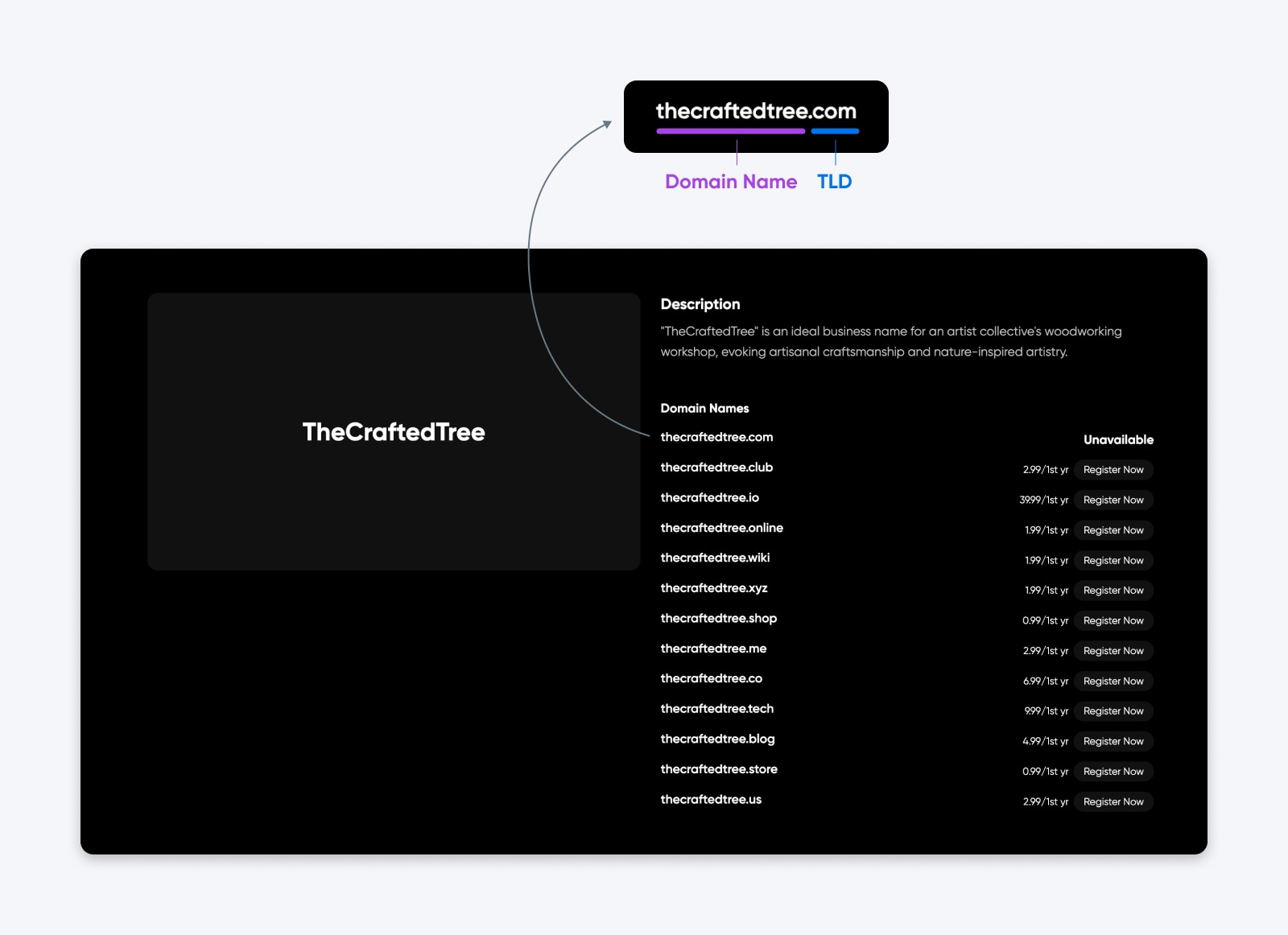
3. Incorporate Targeted Keywords
Want customers to be able to find your site via a Google search? Keywords aren’t just for content. Search engines use your domain name to understand what your site is about and help determine its position in search rankings. That’s why it’s essential to try to include relevant keywords in your domain if you can.
The keywords you choose for your domain should be relevant to your website and targeted to your audience. If you’re having trouble thinking of good ideas, Search Engine Optimization (SEO) tools can help. Semrush, Moz, and Ahrefs are powerful and popular options, and Google Keyword Planner is a free tool that lets you do some basic keyword research like explore keywords by search volume.
SEO
Search Engine Optimization (SEO) is the practice of improving a site’s ranking in search results. Search results are aggregated based on a number of factors, including a site’s relevance and quality. Optimizing your site for these factors can help boost your rankings.
Read MoreIn addition to choosing keywords that are relevant to your website, you can explore what the most trendy keywords are at any moment and try to find a matching keyword with your domain and your brand. One of the best resources for this is dotDB’s top keywords, which are updated on a daily basis. Other options include using the 20 most popular keywords of all domains that have ever been registered; this will give you a general picture of which keyword is most ideal for a website.
Remember that a domain name doesn’t give you a lot of space to work with (and the shorter your domain name is, the more SEO-friendly it will be), so only use keywords when they fit in naturally.
4. Make Sure Your Domain Is Easy To Pronounce And Spell
While you want your domain name to be original so it stands out, novelty isn’t always a good thing. Modifying the spelling of a common word to snag the .com extension (or just to be more unique) can confuse your audience and make your site harder to find.
Word-of-mouth advertising is a powerful thing, but it only works when people can pronounce your brand name. A good domain name needs to be easily pronounceable because that makes it easier to remember, increasing the odds that people will visit and recommend your site among their personal, social, and business networks.
So, what’s an easy way to make sure your domain is memorable and easy to pronounce? Use the four-letter pattern c-v-c-v (consonant-vowel-consonant-vowel) like Meta or c-c-v-c (consonant-consonant-vowel-consonant) like Snap. These patterns are simple to say and easy to remember.
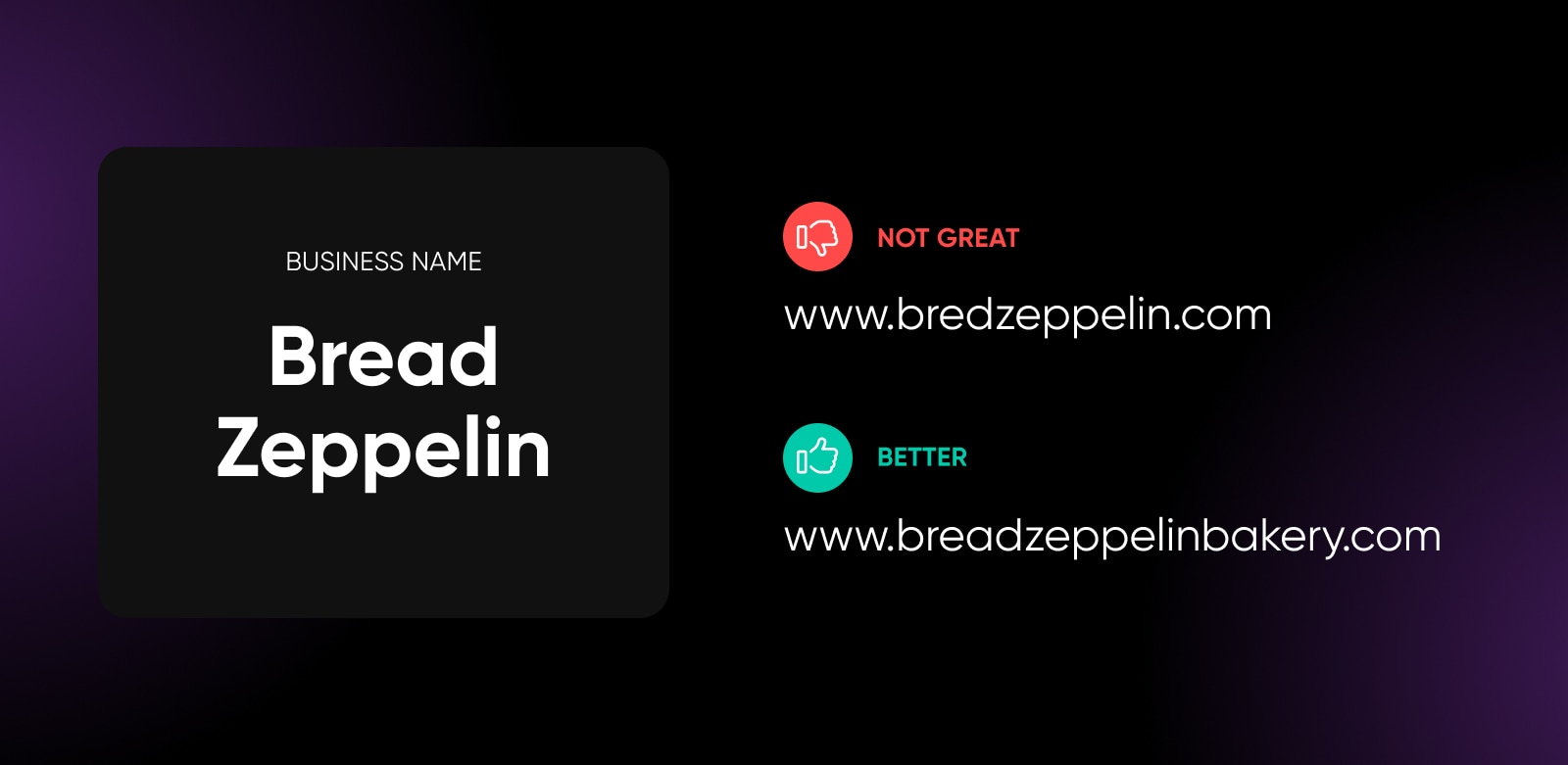
5. Avoid Hyphens, Abbreviations, And Doubled Letters
Using hyphens in a domain isn’t always a no-go (it works for www.deutsche-bank.com, for example), but hyphens are tough to express verbally (do you say “dash” or “hyphen” out loud?). Additionally, they make your domain more difficult to type, which is why it’s still a best practice to avoid them.
The same goes for abbreviations, which are also difficult to say out loud and can easily be mistyped or misspelled. Also, try to avoid anything that isn’t a letter. This includes replacing letters with numbers, which makes the domain a lot easier for people to mistype.
While there are exceptions when you’re brainstorming domain name ideas, it’s best to avoid double letters — they’re just asking for typos! Doubled letters are hard to read and even harder to type correctly. If mistakes happen often enough, you may end up with someone typosquatting and stealing your traffic.
6. Keep Your Domain Name Short
We’ve already alluded to this, but short domains work better for many reasons: they’re easier to remember, faster to type, and better for SEO.
This is especially important as more and more people are browsing the internet on mobile devices. A short domain name means fewer opportunities for mobile users to get blindsided by maddening autocorrect.
This might mean you need to get creative with your company name. While it’s ideal to use a brandable domain (a domain name that’s the same as your company name, like Amazon.com for Amazon), you might need to shorten your domain to make it as user-friendly as possible. For example, if your company name is Eli’s Tea Bar and Cake Shop, your domain could be shortened to elistea.com or even elis.tea.
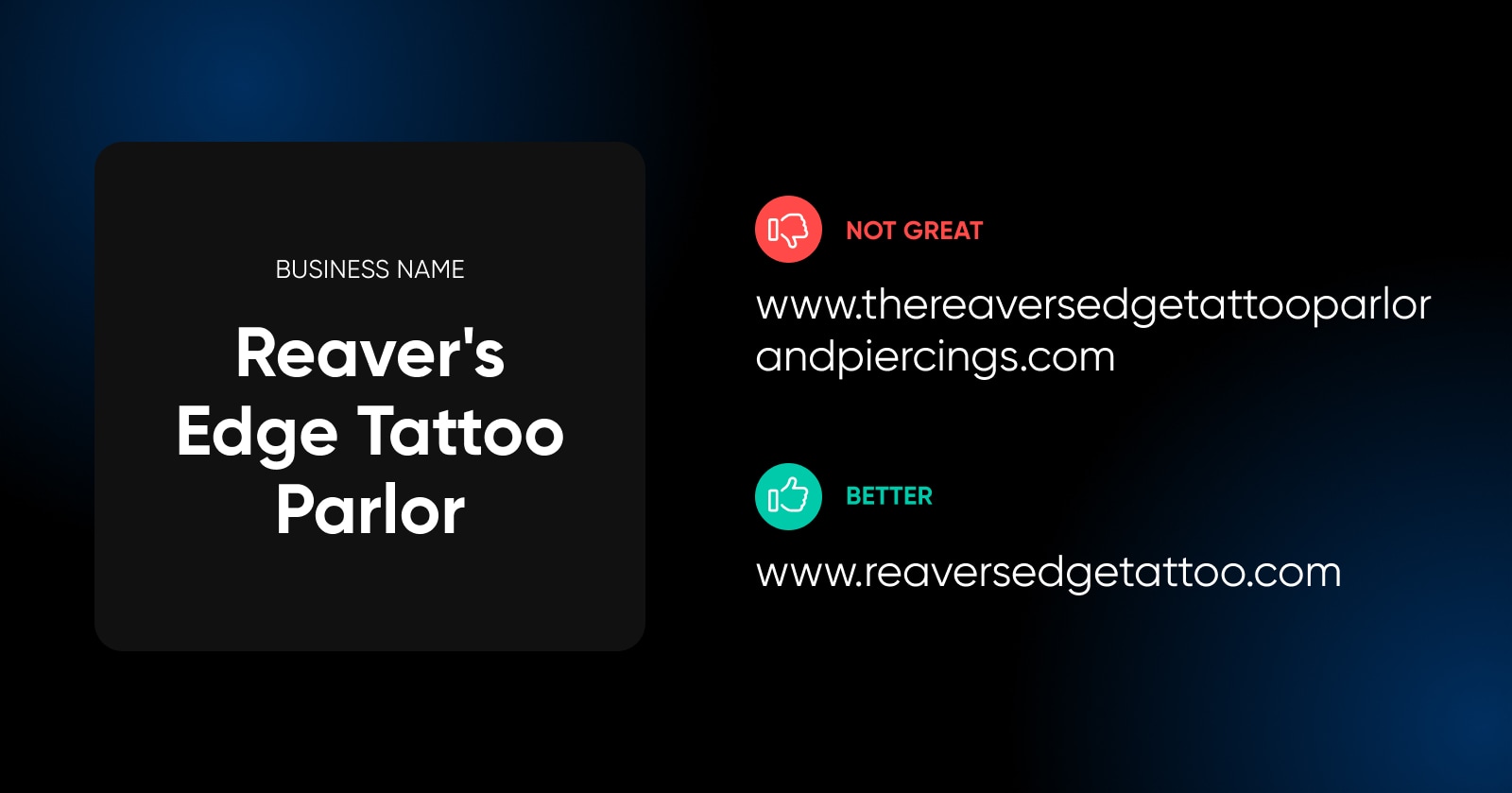
7. Pick A Domain Name That’s Flexible
Your domain name is one area where you don’t want to put yourself into a box. While you should be specific enough to attract an audience, you don’t want to be so precise that there’s no room for your website to grow.
For example, “shutter.photography” might be perfect for a photography blog. However, if you decide to write about other art forms in the future, you’ll be stuck with an inaccurate domain name.
That’s why it’s a good idea to think about how your site or business may expand over time when choosing your domain. Make this decision with long-term vision, and you’ll be less likely to limit yourself (and your business) in the future.
8. Check The Domain History
Once you’ve landed on a brilliant domain name, it’s important to do a bit of homework before you purchase it. While some domains are completely fresh, it’s possible that a domain you have your eye on had a previous owner.
It’s a good idea to investigate the domain’s history since activity on the site before you purchased it can affect your site’s SEO. You also want to avoid purchasing a domain that hosted an unethical or illegal website in the past since that can hurt your business’s reputation.
There are different tools you can use to check on your domain’s past. Try Wayback Machine or Whoxy to start with.
9. Research Social Media Handles
Of course, when you have an online business presence, your domain name isn’t the only thing that matters! In the digital age, you need social media, too. It’s crucially important to consider social media when choosing your domain.
You’ll want to have social media handles that are, ideally, the same as your domain (or at least very similar). So, while you’re checking domain name availability, make sure to check social media sites to see if matching handles are available, too.
10. Don’t Miss Out On A Deal
Whether you have a big corporation or a small business, you probably have a budget for your website. But if you’re running a small business or you’re self-employed, that budget might be pretty tight.
Domain name prices can vary by a lot, depending on many factors. Often, one of those factors can be how popular a desired domain name option is perceived to be. If your desired domain is considered “premium,” it could cost hundreds of thousands of dollars!
Premium Domain
A premium domain has a short and memorable name and a popular extension. Many premium domains are already registered because of their high demand, and available options typically have high prices.
Read MoreOn the other hand, when you’re new to building websites and registering a domain, sometimes you can luck out and find low introductory prices — scoring valuable domain names at deep discounts this way.
If you see a great deal for a good domain name, don’t hesitate to act!
11. Protect Your Brand With Multiple Domains
Let’s say you snag the perfect .com address. You’re done, right? Well, not necessarily!
You may still want to consider purchasing other TLD variations and having them redirect to your site. You can even go a step further and purchase common misspellings of your domain name and redirect those, too. That way, you never miss out on traffic due to “user error.”
If you decide to register multiple TLDs, you can always check how many similar domains with various extensions (TLDs) have been registered worldwide by using this tool. It will give you a hint that a selected domain is — or is not — popular and has been registered multiple times in other TLDs or ccTLDs.
You can apply this strategy to social media. Even if you don’t think you’ll use X (formerly known as Twitter), if the handle matching your domain is available, grab it. It might be good to have in the future, and by registering it yourself, you prevent anyone else from taking it.
12. Pick The Best Domain Registrar For Your Website
Once you’ve chosen your new domain name, there’s just one step left: registering your domain. For this, you’ll need to choose a domain registrar, which is the company where you purchase your domain.
It’s a good idea to shop around for a domain registrar since different companies offer different features at different price points. Here are a few things to look out for:
- Domain transfers. Check the registrar’s transfer policy. If it’s complicated or expensive to transfer your domain, keep looking.
- Pricing. Some companies offer lower prices for the first year and then increase them when it’s time for renewal. You may even be locked into a multi-year contract.
- Expiration policy. If you forget to renew the lease on your domain, someone else can take it from you. Therefore, look for a registrar that offers automatic renewals and a grace period so you don’t risk losing your domain.
- Domain privacy protection. As a website owner, you’re required to add your personal information to a public database. Domain privacy protection hides your primary contact information to help keep your identity secure.
- Subdomains. You don’t have to register subdomains separately. However, you’ll want to ensure that your registrar makes it easy to add subdomains to your site.
- Domain forwarding/domain redirect. Find a registrar that allows you to forward/redirect your recently purchased domain to an under-construction site or a social media handle if you’re not yet ready to build a full website.
Subdomain
A subdomain is a second-level domain that is part of a larger domain. Subdomains can be used to create separate web elements within a single domain. For example, the website blog.example.com might be a subdomain of the example.com domain.
Read MoreThere are lots of registrars you can use. However, if you’re considering using a hosting provider, you may want to look into whether they also offer domain registration. You may be able to get a good deal by registering your domain with the same company that hosts your site, which brings us to our last tip!
How To Get A Free Domain With Your Web Hosting
Some web hosts offer a free domain name when you sign up for a hosting plan. This is especially common if you use a website builder. They want to make the process as simple and streamlined as possible for you, so they allow you to purchase your domain and build your site at the same time.
If you want the power of WordPress plus managed hosting for your domain that optimizes the entire experience to help your business grow, you need our DreamPress service. DreamPress — managed WordPress hosting — plans make WordPress faster, more secure, and easier to use. To top it off, every one of our plans comes with a free domain name!
Or, if you already have a registered domain, we’ll help you migrate it to WordPress for free. You also get built-in caching, one-click staging, bulletproof backups, and 24/7 support from our highly-trained WordPress pros.
A Strategic Approach To Choosing The Perfect Domain Name
Your domain name is your chance to leave a good first impression on visitors to your site. That’s why a good domain name is essential if you want your website to stand out and succeed.
If you’re ready to land the perfect domain name, remember these tips as you start your search.
Good luck!
[bng]
The post 12 Tips For Choosing The Perfect Domain Name For Your Website appeared first on DreamHost Blog.
]]>The post What Is the DNS_PROBE_FINISHED_NXDOMAIN Error? A Definitive Guide appeared first on DreamHost Blog.
]]>But like all good error codes, the statement doesn’t provide any context as to why the site isn’t loading and what could be the possible culprit. At least, not right away.
In this definitive guide to the DNS_PROBE_FINISHED_NXDOMAIN Error, we will walk you through the step-by-step process necessary to troubleshoot this error and fix it for good, either as an internet user or a website administrator. Read on to find out more.
What is the Domain Name System (DNS)?
DNS, short for Domain Name System, is a bit like a telephone directory from the analog era.
What is DNS?
The Domain Name System (DNS) protocol keeps records of which domain names correspond to specific IP addresses. This system enables you to browse the web by typing in regular URLs instead of IP addresses.
Read MoreBut instead of phone numbers, DNS matches domain names (like “dreamhost.com”) to their IP addresses. It’s the reason we don’t have to memorize 12-digit serial numbers for every single website we visit, because it allows us to supplement it with their much cooler domain names!
But sometimes, DNS servers can also act up and lead to error codes like DNS_PROBE_FINISHED_NXDOMAIN. It’s definitely not a pleasant experience for the visitor trying to access your website, so it’s important to know how to troubleshoot the issue should you encounter it.
DNS Servers: How Do They Work?
DNS servers are the computer servers responsible for keeping the DNS systems up to date. They do this by matching a domain name to its IP Address.
Whenever you type in a URL, your web browser sends a query to a DNS server which then pulls out the website via its IP Address. Of course, that’s the simple explanation.
In reality, DNS servers are hierarchy-based. When you type a web address into your browser, your computer sends a request to a DNS resolver, which is typically provided by your internet service provider (ISP). The resolver then queries the DNS root server, which is just the first step in the domain name lookup process.
The DNS resolver then checks its cache to see if it already knows the IP address for that domain name. If it doesn’t, it sends a request to a DNS root server to determine which DNS servers are authoritative for the top-level domain.
The DNS resolver then sends a request to one of the authoritative DNS servers for the top-level domain to get the IP address associated with that domain name.
Once the DNS resolver gets the IP address, it caches it so that it can respond more quickly if it receives another request for that same domain name. It then returns the IP address to your device, which uses the IP address to establish a connection with the web server hosting the website you want to visit.
This entire process usually takes just a few milliseconds! That’s pretty amazing, considering how many requests are being sent and received behind the scenes.
That being said, there are many steps to the process, which leaves plenty of room for error if one of these systems decides to act up. Next, let’s try to understand what leads to an error code and how you can go about resolving it.
The DNS_PROBE_FINISHED_NXDOMAIN Error, Explained
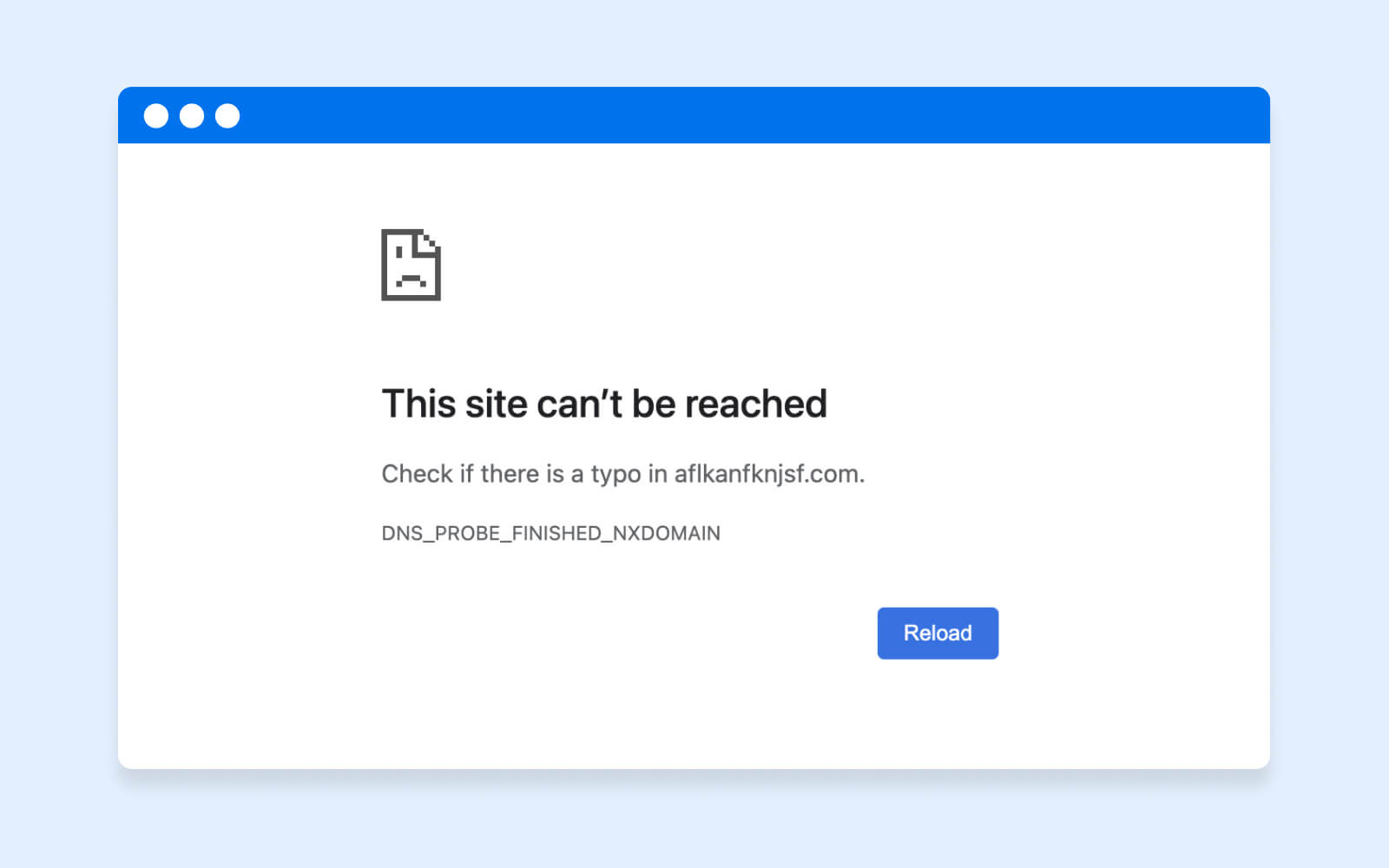
DNS_PROBE_FINISHED_NXDOMAIN is a common error that occurs when your device is unable to resolve the domain you are trying to access. NXDOMAIN stands for “Non-Existent Domain,” meaning the domain name you entered does not exist in the DNS.
Essentially, when you enter a domain name in your web browser, your device sends a DNS query to a DNS resolver to find the IP address associated with that domain name. If the DNS resolver is unable to find the IP address for the domain name you entered in its cache, it sends a request to one of the authoritative DNS servers for the top-level domain to get the IP address.
However, if the authoritative DNS server also fails to get the IP address corresponding to the domain name, it returns a “Non-Existent Domain” (NXDOMAIN) response to the DNS resolver, which then passes on the same error message to your browser.
How can you tell if you’ve encountered a DNS_PROBE_FINISHED_NXDOMAIN error when accessing a website? Based on your preferred web browser, it may display as one of the following error messages:
- Google Chrome: This site can’t be reached.
- Mozilla Firefox: Hmm. We’re having trouble finding that site.
- Microsoft Edge: Hmm… can’t reach this page.
- Apple Safari: Safari Can’t Find the Server.
What Causes the DNS_PROBE_FINISHED_NXDOMAIN Error?
DNS_PROBE_FINISHED_NXDOMAIN is an error that can occur from both client-side (due to the visitor’s browser) and server-side (because of the website’s backend) reasons. There are a lot of possible circumstances that could result in the error, such as:
Client-Side Causes
- Incorrect URL: If you have entered an incorrect URL or misspelled the domain name, it can result in the DNS_PROBE_FINISHED_NXDOMAIN Error.
- Incorrect DNS Settings: DNS_PROBE_FINISHED_NXDOMAIN errors also happen if the DNS configuration on your device is incorrect or has been changed. This can occur if you have recently changed your internet service provider or made changes to your network settings.
- Firewall or Antivirus Settings: Sometimes, VPNs, firewalls, or antiviruses can block access to some websites, resulting in the DNS_PROBE_FINISHED_NXDOMAIN Error.
- DNS Cache Issues: Your device’s DNS cache stores information about recently accessed websites — This can lead to a DNS_PROBE_FINISHED_NXDOMAIN error if the cache becomes corrupted or outdated.
Server-Side Causes
- DNS Server Issues: Sometimes, DNS servers can experience issues or go down. This can happen for several reasons, such as server overload or maintenance. When this happens, this error can occur.
- Expired Domain Names: If the domain name of the website you are trying to access has expired, it can result in the DNS_PROBE_FINISHED_NXDOMAIN Error. This can happen if the website owner forgets to renew their domain name registration.
- DNS Hijacking: DNS hijacking is a technique hackers use to redirect users away from legitimate websites. If your device has been affected by DNS hijacking, it can result in the DNS_PROBE_FINISHED_NXDOMAIN Error.
- DNS Propagation Lag: When a website’s DNS records are changed, it can take some time for these changes to propagate throughout the internet. During this propagation period, some users may experience the DNS error, as their device is still trying to access the old DNS records.
Troubleshooting the DNS_PROBE_FINISHED_NXDOMAIN Error: For Desktop
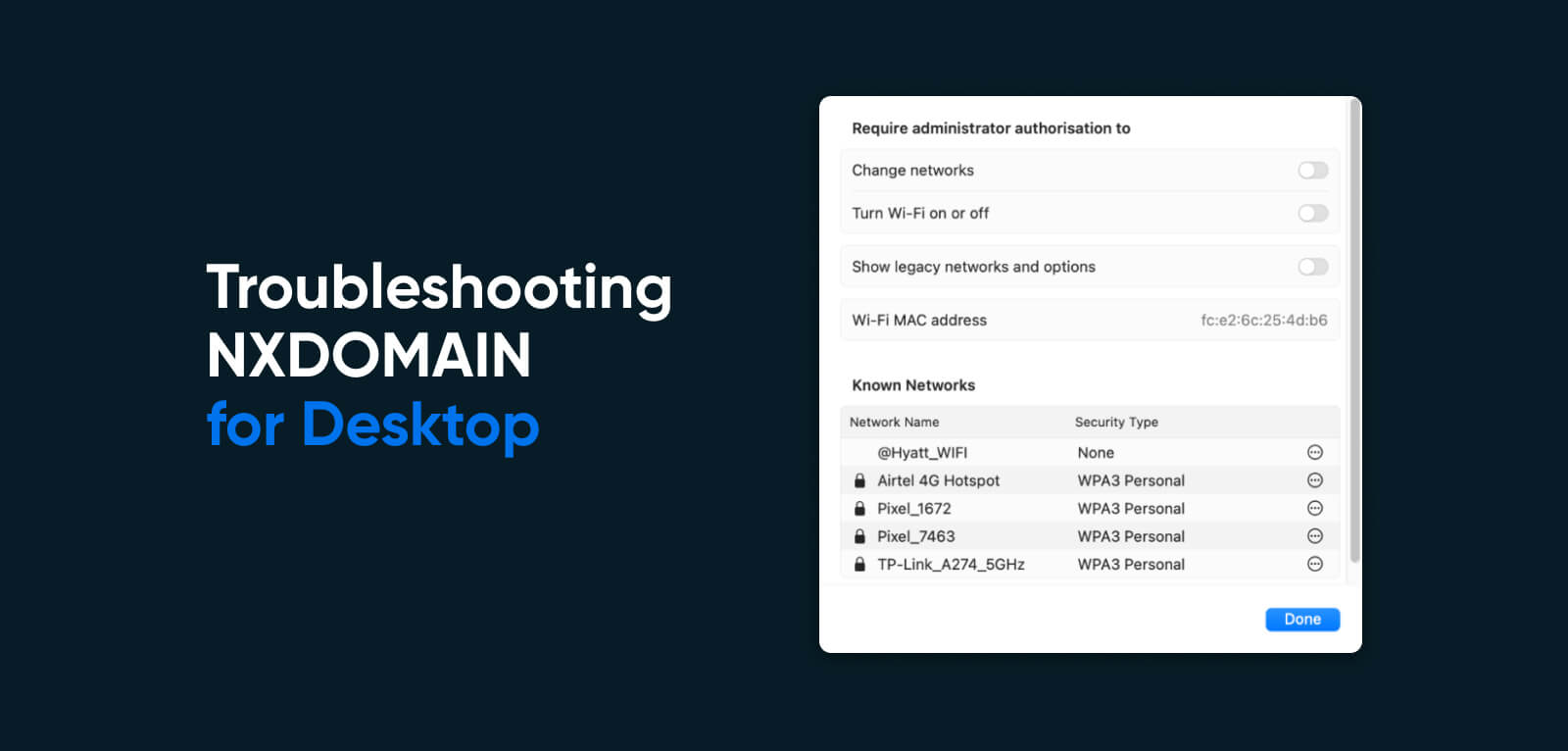
If you keep encountering a DNS_PROBE_FINISHED_NXDOMAIN error when trying to visit a specific website, there are a few things you can do to resolve any client-side issues that may be causing the problem.
These will vary depending on the type of device and operating system you are using, but here are some ways to troubleshoot the DNS error on a desktop device (Windows or Mac). Try these only after you’ve performed basic troubleshooting steps, like rebooting your internet connection and disabling your antivirus software.
Flush Your DNS Cache
The DNS cache is a temporary database stored on your device that contains information about previously accessed domain names and their corresponding IP addresses.
Cache
A “cache” (pronounced “cash”) is hardware or software that stores data. Many devices, web browsers, web servers, and applications use caching. In theory, cache memory allows for data to be fetched more rapidly. A corrupted or overfull cache can cause performance issues.
Read MoreWhen you access a website, your device first checks its DNS cache to see if it already has the IP address for that website. If it does, then your device doesn’t need to query a DNS server to find the IP address, which can speed up the website loading process.
However, if the DNS cache becomes corrupted or contains outdated information, it can lead to issues like the DNS_PROBE_FINISHED_NXDOMAIN Error. In such cases, flushing the cache can often resolve the issue. Here’s how to flush the DNS cache in Windows, macOS, and Google Chrome:
Windows: To flush the DNS cache in Windows, follow these steps:
- Open the Command Prompt by pressing the Windows key + R, typing “cmd” in the Run dialog box, and pressing Enter.
- In the Command Prompt, type “ipconfig /flushdns” and press Enter.
- You should see a message saying, “Successfully flushed the DNS Resolver Cache.”
macOS: To flush the DNS cache in macOS, follow these steps:
- Open the Terminal app by going to Applications > Utilities > Terminal.
- Type “sudo killall -HUP mDNSResponder” in the Terminal and press Enter.
- You will be prompted to enter your administrator password. After entering it, press Enter.
- You should see a message saying “mDNSResponder restarted.”
Google Chrome: To flush the DNS cache in Google Chrome (Chrome has its own DNS cache that’s separate from Windows or macOS), follow these steps:
- Open a new tab in Google Chrome.
- Type “chrome://net-internals/#dns” in the address bar and press Enter.
- Click the “Clear host cache” button.
- You should see a message saying, “Host cache has been flushed.”
Release and Renew IP Address
When you release your IP address, you are essentially telling your device to forget its current network configuration. When you renew your IP address, your device will request a new IP address from the DHCP server, which can often resolve issues with your network connections. Here’s how to release and renew your IP address on Windows and macOS:
Windows: To release and renew your IP address on Windows, follow these steps:
- Open the Command Prompt by pressing the Windows key + R, typing “cmd” in the Run dialog box, and pressing Enter.
- Type “ipconfig /release” in the Command Prompt and press Enter.
- You should see a message saying, “Successfully released the IP address.”
- Next, type “ipconfig /renew” and press Enter.
- You should see a message saying, “Successfully renewed the IP address.”
macOS: To release and renew your IP address on macOS, follow these steps:
- Click on the Apple menu and select System Preferences.
- Click on the Network icon.
- Select the network interface you are currently using (e.g., Wi-Fi, Ethernet) from the list on the left.
- Click on the Advanced button in the bottom-right corner.
- Click on the TCP/IP tab.
- Click on the “Renew DHCP Lease” button.
Change your DNS Servers
If the default DNS servers provided by your internet service provider (ISP) are not working correctly, changing them to a third-party DNS provider may help. Here’s how to change DNS servers on Windows and macOS:
Windows: To change the DNS servers on Windows, follow these steps:
- Open the Control Panel and click on “Network and Sharing Center.”
- Click on the connection you are currently using (e.g., Wi-Fi, Ethernet).
- Click on the “Properties” button.
- Select “Internet Protocol Version 4 (TCP/IPv4)” and click on the “Properties” button.
- Select the “Use the following DNS server addresses” option.
- Enter the IP addresses of the preferred DNS servers you want to use (e.g., 8.8.8.8 for Google DNS).
- Click on the “OK” button.
macOS: To change the DNS servers on macOS, follow these steps:
- Click on the Apple menu and select System Preferences.
- Click on the Network icon.
- Select the network interface you are currently using (e.g., Wi-Fi, Ethernet) from the list on the left.
- Click on the Advanced button in the bottom-right corner.
- Click on the DNS tab.
- Click on the “+” button to add a new DNS server.
- Enter the IP address of the alternate DNS server you want to use (e.g., 8.8.8.8 for Google’s public DNS server).
- Click on the “OK” button.
Restart your DNS Client Service
The DNS client service is responsible for resolving domain names into IP addresses. If the service is not working correctly, it can lead to issues with internet connectivity. Here’s how to restart the DNS client service on Windows:
- Open the Run dialog box by pressing the Windows key + R.
- Type “services.msc” in the Run dialog box and press Enter.
- In the Services window, scroll down and locate the “DNS Client” service.
- Right-click on the “DNS Client” service and select “Restart” from the context menu.
- After a few moments, a message should appear saying that the service has been restarted.
In addition to resolving DNS-related issues, restarting the DNS Client service can also help improve internet speeds and reduce latency.
Check your Local Hosts File
The local host file is a text file stored on your computer that maps domain names to IP addresses. When you type a domain name into your web browser, your computer checks the local host file first, to see if it has a mapping for that domain. If the mapping exists, your computer uses that IP address to connect to the website. If it doesn’t, your device queries a DNS server to get the IP address.
The NXDOMAIN error occurs when the DNS server cannot find a mapping for the domain name you entered. Editing the local hosts file can fix this issue.
Windows: To edit the local hosts file on Windows, here’s what you need to do:
- Open File Explorer and navigate to the following directory: C:WindowsSystem32driversetc
- Right-click the “hosts” file and select “Open with,” and then choose “Notepad.”
- Scroll down to the bottom of the file and find the line that contains the incorrect entry causing the NXDOMAIN error.
- Edit or delete the line as necessary to fix the error.
- Save the changes to the file and close Notepad.
- Open the Command Prompt by clicking on Run as Administrator and enter the following command: ipconfig /flushdns
- Restart your computer to ensure the changes take effect.
macOS: To edit the local hosts file on macOS, here’s what you need to do:
- Open the Terminal app from the Applications > Utilities folder.
- Type the following command and press Enter: sudo nano /etc/hosts
- Enter your user password when prompted.
- Use the arrow keys to navigate to the line that contains the incorrect entry causing the NXDOMAIN error.
- Edit or delete the line as necessary to fix the error.
- Press Command+O to save the changes to the file, and then press Command+X to exit nano.
- Run the following command to clear the DNS cache: sudo killall -HUP mDNSResponder
- Restart your computer to ensure the changes take effect.
Reset your Chrome Flags
Chrome flags are experimental features that allow users to enable and disable various settings in the Chrome browser. These flags are not recommended for general users as they may impact the stability and security of the browser. However, some users may enable certain flags to test new features or resolve issues.
One flag that may cause the NXDOMAIN error is the “Async DNS resolver” flag. This flag is designed to speed up DNS resolution by performing lookups in parallel with other browser activities. However, it may conflict with certain DNS servers or network configurations, resulting in the NXDOMAIN Error.
To reset Chrome flags and resolve an NXDOMAIN error, follow these steps:
- Open the Chrome browser and type “chrome://flags” in the address bar.
- Scroll down to the “Reset all to default” button at the bottom of the page and click it.
- Confirm that you want to reset all flags to their default settings.
- Restart the Chrome browser to ensure the changes take effect.
After resetting the Chrome flags, the “Async DNS resolver” flag will be disabled, and the browser should no longer encounter the NXDOMAIN error. If you want to re-enable specific flags, you can do so one at a time and test each individually to ensure they do not cause any issues.
Troubleshooting the DNS_PROBE_FINISHED_NXDOMAIN Error: For Mobile
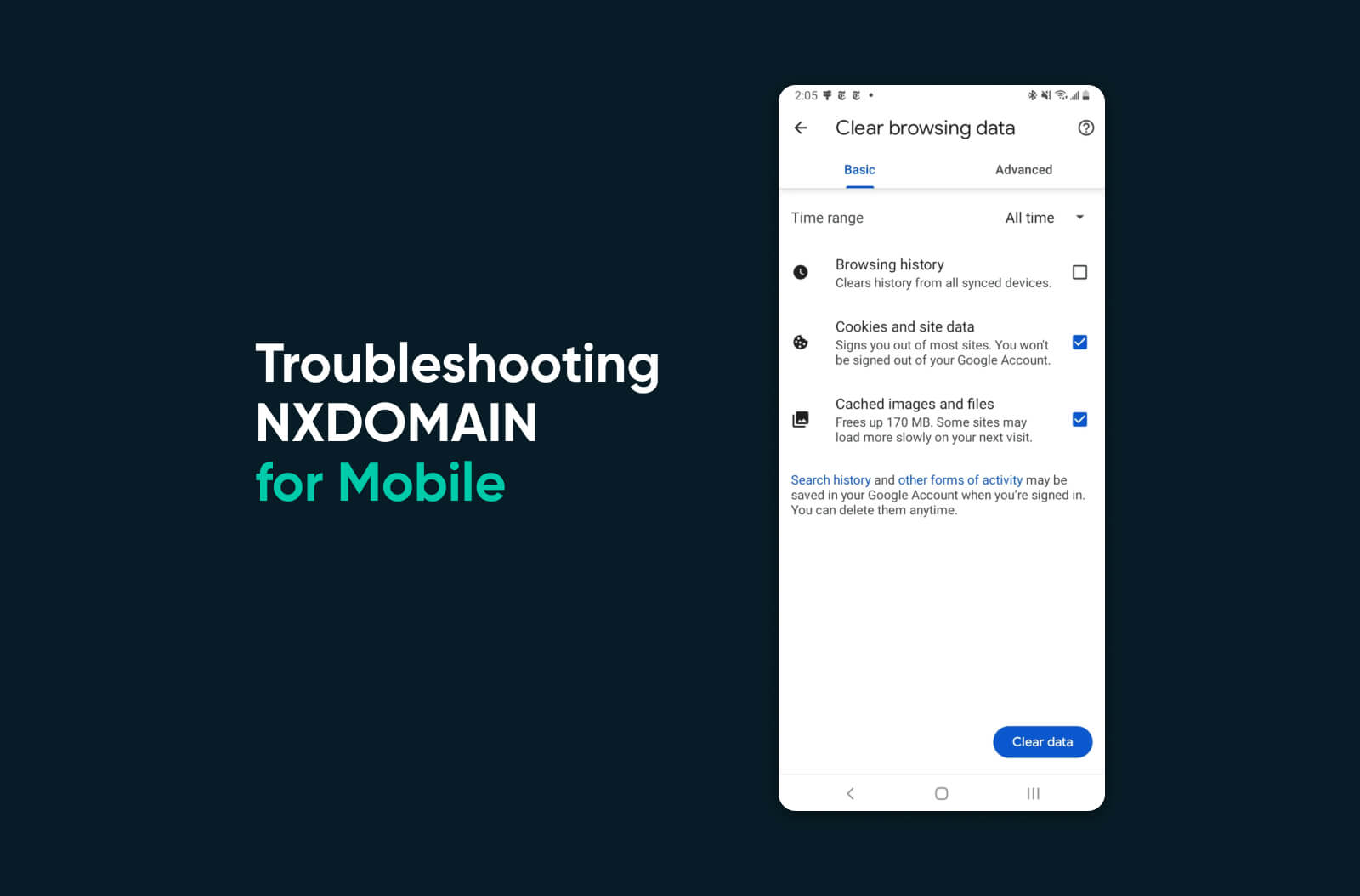
The reasons leading to an NXDOMAIN error on smartphones differ from those on desktop devices. If you’re an Android or iOS user who keeps running into this DNS issue, here are some tutorials to help resolve the issue:
Android
- Make sure that your device is connected to a stable Wi-Fi or mobile data network. If your connection is unstable, it may cause the NXDOMAIN error. To check your connection, go to Settings > Wi-Fi, or Settings > Network & Internet, and ensure that your device is connected to an active network.
- Clearing the browser cache can help resolve the NXDOMAIN error. To clear the cache, go to Settings > Apps & notifications > See all apps > Chrome (or the browser you’re using) > Storage & cache > Clear cache.
- Changing the DNS settings can also help resolve the error. To do this, go to Settings > Wi-Fi (or Network & Internet) > Wi-Fi preferences > Advanced > Private DNS. If you have a custom DNS server, select “Private DNS provider hostname” and enter the hostname. If you don’t have a custom DNS server, select “Automatic” to use your mobile carrier’s DNS server.
- VPN or proxy settings may cause the NXDOMAIN error, especially if they are misconfigured. To disable VPN or proxy settings, go to Settings > Network & Internet > VPN (or Proxy) and turn off any enabled settings.
- If the NXDOMAIN error persists on your current browser, try using a different browser to access the website. This will help rule out any browser-specific issues. Some popular browsers for Android include Chrome, Firefox, Ecosia, and Opera.
- Resetting the network settings can help resolve any network-related issues that may be causing the NXDOMAIN error. To do this, go to Settings > System > Reset options > Reset Wi-Fi, mobile & Bluetooth.
iOS
- To check your connection on your iPhone, go to Settings > Wi-Fi, or Settings > Cellular, and ensure that your device is connected to an active network.
- To clear browsing data on Safari, the default web browser for iOS, go to Settings > Safari > Clear History and Website Data.
- Restarting your device can also help resolve any network or DNS issues. To restart, press and hold the power button until the “slide to power off” option appears. Slide the button to power off your device, then press and hold the power button again to turn it back on.
- To disable VPN or proxy settings on iOS, go to Settings > General > VPN (or Profiles) and turn off any enabled settings.
- If the NXDOMAIN error persists on your current iOS browser, try using a different browser to access the website. This will help rule out any browser-specific issues. Some popular browsers for iOS include Safari, Chrome, and Firefox.
- To reset the network settings on your iPhone and resolve an NXDOMAIN error, go to Settings > General > Reset > Reset Network Settings.
Troubleshooting the DNS_PROBE_FINISHED_NXDOMAIN Error: As a Site Administrator
When client-side solutions fail, visitors will inevitably reach out to you — the website owner — for help with the NXDOMAIN Error. Here’s what you can do as an administrator to help diagnose and fix the issue:
- The first step in troubleshooting the NXDOMAIN error is to check your DNS configuration. Ensure that your DNS records are correctly configured, and your domain name is registered with a valid DNS provider. You can use tools like DNS Checker or MX Toolbox to check your DNS configuration.
- If your DNS server is experiencing issues or not running, this can cause an NXDOMAIN error. To verify that your DNS server is running, check your server logs or use a tool like DNSstuff to perform a DNS lookup.
- If your domain name is not registered correctly, it can cause the NXDOMAIN error. Check with your domain registrar to ensure your domain name is registered and that your DNS records are correctly configured.
If your DNS records are incorrect or outdated, it can cause the NXDOMAIN error. Update your DNS records to ensure that they are correct and up-to-date. You can use tools like DNSimple or Cloudflare to manage your DNS records.
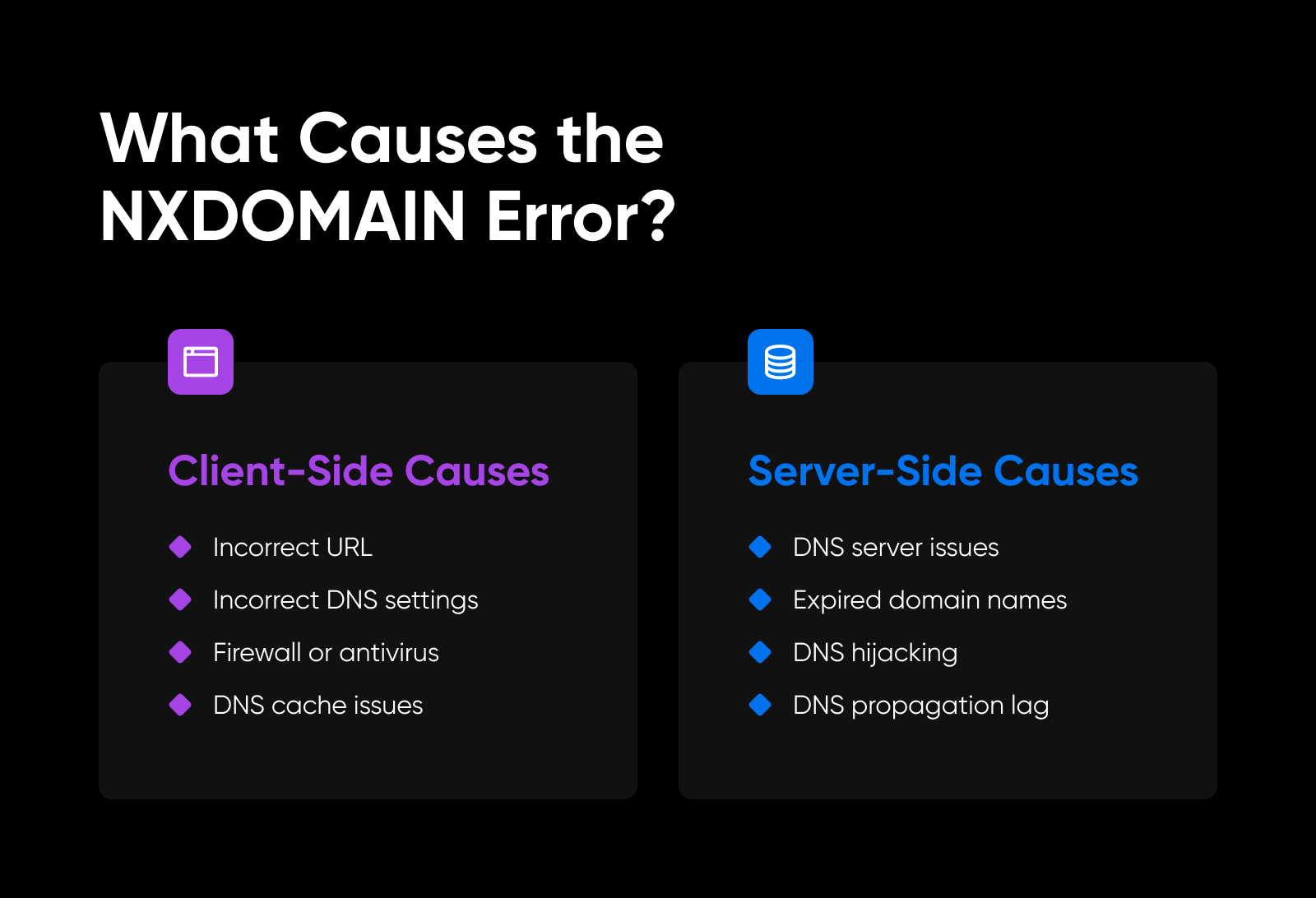
DNS_PROBE_FINISHED_NXDOMAIN Error: Wrapping Up
DNS servers can be complicated. If nothing else works out for you, site admins always have the option to speak to their domain registrar or hosting provider for help diagnosing the issue. If you don’t have access to a support team, consider bringing in a freelance developer to fix it for you.
However, working through the above solutions should fix your NXDOMAIN error about 95% of the time. We hope this helps!

Private Domain Registration For All
Don’t let someone else register your domain first. Search DreamHost’s 400+ TLDs to find the perfect fit for your website.
Master Your DomainThe post What Is the DNS_PROBE_FINISHED_NXDOMAIN Error? A Definitive Guide appeared first on DreamHost Blog.
]]>The post Private Domain Registration FAQs appeared first on DreamHost Blog.
]]>The good news is that private domain registration replaces your personal information with generic placeholders through a web host or registrar. You can usually opt for private registration when purchasing a domain, though privacy can also be added to your existing domains.
This article should help you answer 13 frequently asked questions about private domain registration. Let’s dig in!
What Personal Information Is Required When Registering a Domain?
When registering a domain, you’ll need to provide your name, physical address, phone number, and email address. This contact information is used to track ownership of the domain. It is made publicly available online via the WHOIS directory.
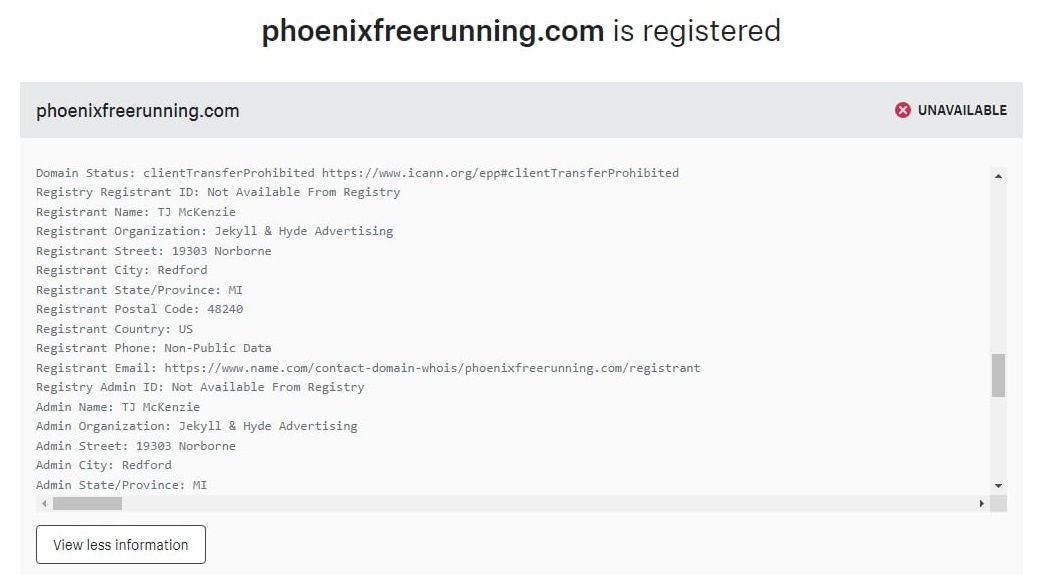
Other data is also made available, such as the year and date the domain was registered, when it was last updated, and when it will expire. Technical information like the domain status and server name can also be found.
Why Do I Need to Provide Personal Information to Register a Domain?
There are countless domains on the web which are being bought, sold, and created every day. Keeping track of them is no simple task, and a method to track them is essential. While some may not like it, the current approach is to post domain registration information publicly online for all to see.
This information is used to prove ownership of the domain. This type of record is essential in the event of a dispute.
In addition, registering a domain is necessary for regulating online activity. For instance, if an online business is involved in illegal transactions, the authorities may need to contact the website owner to resolve the issue.
What Is WHOIS?
WHOIS is a public database of all website domains. It includes personal information about every website owner. This directory is intended to track ownership of domains, though spammers and scammers are increasingly abusing it.
The WHOIS directory is maintained by the Internet Corporation for Assigned Names and Numbers (ICANN). Their duty is to manage and maintain domain ownership records for technical and legal purposes.
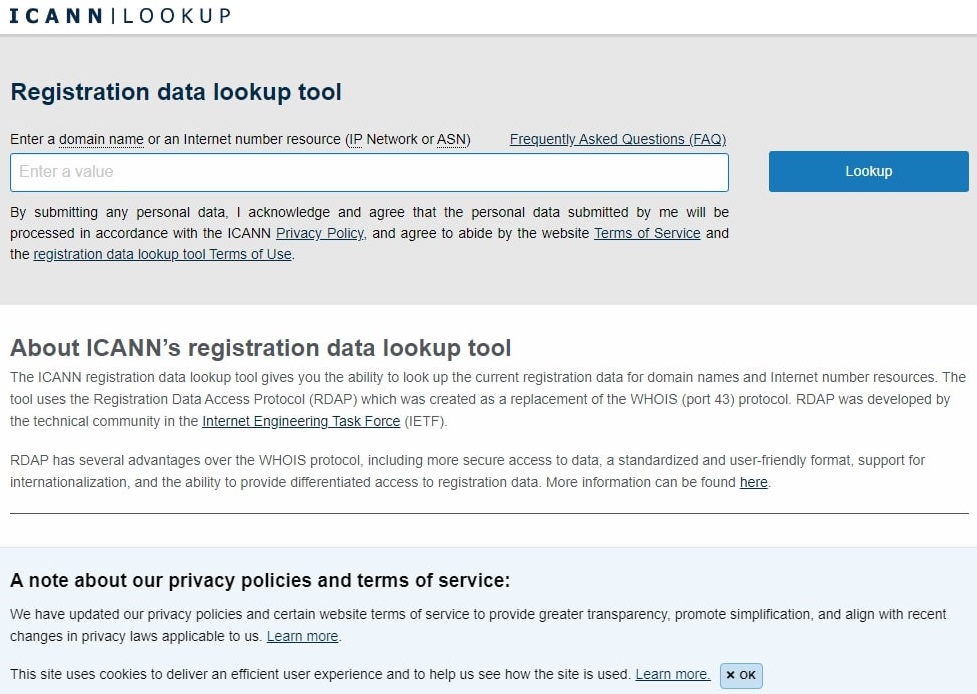
The problem is that this system was implemented a long time ago, and its outdated procedures are vulnerable to modern cybercriminals. Therefore, a replacement for WHOIS, the Registration Data Access Protocol (RDAP), was created to be more secure and to comply with more stringent internet privacy laws such as the GDPR.
While this is a much-needed update, RDAP has yet to be fully implemented and still provides much of the same information as WHOIS. The data used for domain registrations can currently be accessed by anyone. This means that the name, phone number, mailing, and email address of site owners can be exposed.
What Is Private Domain Registration?
Private domain registration allows you to purchase and register a domain without posting your personal information to the public directory. Many web hosts and registrars offer this service.
When you opt for private domain registration, your information is replaced with substitute data from the host or registrar providing the service. If anyone looks up the details in WHOIS for that domain, they are directed to the company providing the privacy service instead of the actual website owner.
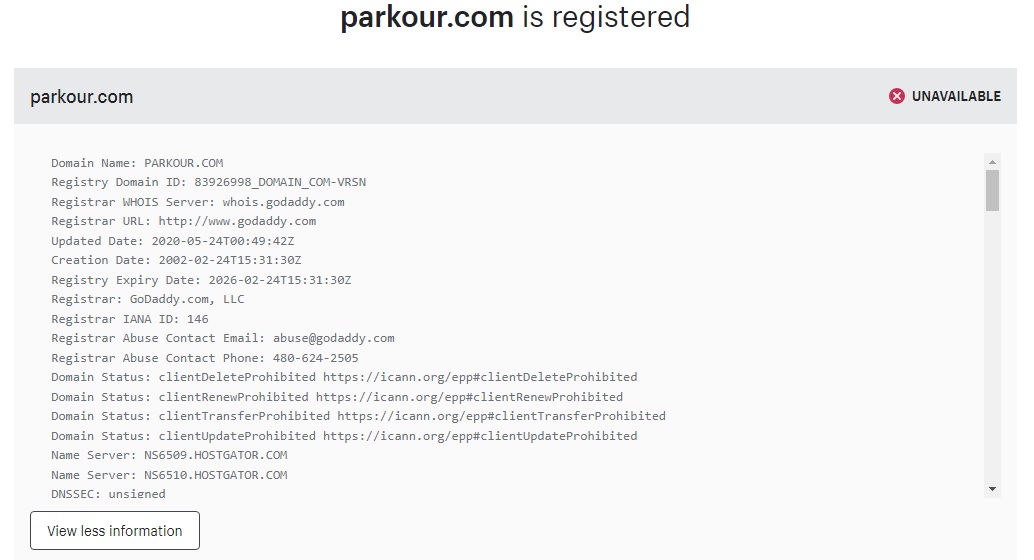
WHOIS requires a name, phone number, email, and mailing address when buying a domain. This information is made public for business and legal reasons, though many people do not wish for their personal information to be publicly available online.
Why Should You Keep Domain Registration Private?
Domain registration requires personal information that should often be kept private. If you wouldn’t post your name, address, and phone number on a billboard, you probably don’t want it available to everyone on the internet.
One of the most common reasons for private domain registration is to avoid spam, identity theft, and harassment. Unfortunately, these days, having your contact details publicly available online puts you at risk of unwanted communication.
While the personal information provided isn’t incredibly sensitive, it could still be used nefariously. For example, with your name, email address, and website information, someone could easily send emails from a fake account similar to yours and pretend to be you. They could use this to phish for account information of your users and compromise your site’s security.
Can I Add Privacy to an Existing Domain?
If you have already registered your domain with your personal information, don’t fret! Usually, you can still apply privacy settings to hide that data.
To do this, check your host dashboard or contact your registrar to request this service. In most cases, your data can be kept private and replaced with a generic placeholder for a nominal fee.

In short, if you wish you had registered privately in the first place, you can still add that privacy now. There is little reason not to, as it could save you from some major headaches in the future.
What Is Domain Privacy Protection?
Domain privacy protection is a service offered by web hosts and domain registrars to keep your personal information hidden from public view. Normally, a domain owner’s contact information is made available in the WHOIS directory for anyone to look up.
However, domain privacy protection acts as a proxy, substituting your information for a generic user number or the name of the service provider. This way, anyone interested can still verify ownership of the domain by contacting your host company or registrar, and you can keep your information off WHOIS.
Unless you have a business phone number, protected email address, and company mailing address, domain privacy protection is likely a worthwhile investment. It can help you avoid spam and ensure your cyber safety. Keep in mind, that even if you have the above business contact information to shield your personal details, you still don’t have to attach it to your domain publicly.
How Do You Keep Domain Registration Private?
To register a domain without sharing your personal information publicly, you’ll need to use a registrar that offers private domain registration. You’ll sometimes pay a small additional fee to get this service, but some hosts include it in their plans.
For instance, you can opt for free private registration when purchasing a domain with DreamHost. That way, your personal information is replaced with a generic placeholder in the public registry:

You can also add privacy to existing domains on DreamHost at no additional cost.
Other registrars and hosting providers may have different methods and pricing for registering privately, but it should be as simple as selecting the option during the purchase process. If you registered without selecting the private registration option, you can usually go back and add it. Better late than never, but keep in mind that some spam bots may have already scraped your email address from WHOIS.
How Much Does Private Domain Registration Cost?
There is no set fee for private domain registration. This service is provided by a number of hosts and registrars that each determine their own price, usually in addition to the base price of the domain.
For example, we offer free private domain registration included in our service at DreamHost. Other companies commonly treat private registration as an add-on and charge $10 to $30 or a recurring monthly fee of around $1 to $2.
In most cases, private domain registration is affordable enough to be worth the peace of mind. You should come across this option when registering your domain with the most popular registrars and web hosts.
Which Domain Extensions Are Eligible for Private Registration?
The majority of common URL suffixes are eligible for private registration. The following popular extensions can be registered privately:
- .com
- .org
- .net
In fact, plenty more extensions can be privately registered. The majority of extensions that cannot be privately registered are geography-specific suffixes (countries, states, etc.) such as:
- .us
- .eu
- .ca
These are not exhaustive lists, and it should be noted that eligibility can change. That’s because Top Level Domains (TLDs) are periodically expanded, and the privacy status of current extensions can be updated. The options available to you can also differ depending on your host and registrar, so be sure to check for privacy compatibility before registering.
How Do I Enable Domain Name Privacy for My Website?
Enabling domain name privacy is usually not something done on your website, per se. Your domain registration information is made available in the WHOIS directory, which is run by ICANN and tracks domain ownership across the web.
To enable domain name privacy, you will need to go through your hosting service or registrar. This option is usually presented during the purchase of the domain, but it can often be added after the fact.
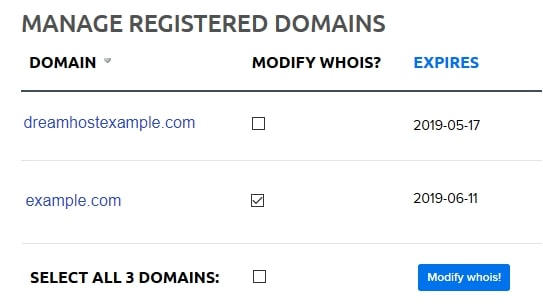
The process will differ depending on the company you use, but it is usually as simple as checking a box or paying for the private registration add-on.
If you are having difficulty finding this option from your hosting dashboard or registrar’s website, you can always contact them to see if they offer this service. If they do not, you may be able to use another company’s privacy service, though this could require transferring your domain to that company.
How Can I Protect Myself from Digital Stalking?
One of the most important things you can do to protect yourself from cyberstalking is to remain anonymous. When possible, avoid using personal information like your real name online. In situations when you must use your real name, avoid pairing it with your contact information.
You may not think anyone will abuse something as simple as your email address, but stalkers can be relentless. For example, you could block an email address that is harassing you, only for that person to start sending emails from a different address.
The bottom line? Keeping personal information private is the best way to avoid digital stalking. However, if it has already begun, it’s a smart idea to seek further help.
Protect Your Online Privacy When You Register a Domain
Now that you have a better understanding of private domain registration, you can protect the personal information attached to your websites. Adding this layer of privacy can help prevent identity theft, hacking attempts, and spam.
To add privacy to your domain, you can either:
- Choose private domain registration when purchasing your domain
- Add domain privacy protection using your host dashboard or by contacting your registrar
DreamHost is one of the most popular hosting and domain services on the web. All of our plans include free private domain registration. Plus, you can easily add it to existing domains too!

Private Domain Registration For All
Don’t let someone else register your domain first. Search DreamHost’s 400+ TLDs to find the perfect fit for your website.
Master Your DomainThe post Private Domain Registration FAQs appeared first on DreamHost Blog.
]]>The post 50 of the Greatest Things Ever Published on The Web appeared first on DreamHost Blog.
]]>In the 29 years since its inception, the web has, of course, expanded. The capabilities have become more useful and the content has become more – well – interesting! In honor of the anniversary, we thought we’d take a trippy trip down memory lane and circle back to recent history by highlighting “50 of the Greatest Things Ever Published on the Web.”
Don’t say we didn’t warn you!
Greatest Memes
Grumpy Cat

We dare say there has probably been no furry internet celebrity more beloved than Grumpy Cat. The frowning feline, whose real name was Tardar Sauce, burst into the popular consciousness in 2012 when her owner posted pictures of her on Reddit. Tardar Sauce’s delightfully dour expression (yes, it was a real, permanent anomaly) made her a star – so much so that she appeared on merchandise and in endorsements and comic books. Sadly, Grumpy Cat is no longer with us, but we’re sure she continues to brighten the realm beyond the Rainbow Bridge with her eternally grouchy demeanor.
Condescending/Sarcastic Willy Wonka

Gene Wilder played the eccentric and, at times, maniacal candy man Willy Wonka in the 1971 movie “Willy Wonka and The Chocolate Factory.” In 2011, the first snarky memes featuring the character began to appear on the internet: a still image of Wonka’s benign facial expression with slogans conveying a condescending, sarcastic attitude. If we got sugared-up enough on Wonka Bars, Fizzy Lifting Drinks, and Everlasting Gobstoppers, we’d have fun coming up with some classic Wonka memes.
Squinting Fry (from “Futurama”)

Originating in a scene in the Season 2 episode “The Lesser of Two Evils” from the oft-resurrected animated comedy series “Futurama,” this image of a squinting Philip J. Fry is usually matched with slogans conveying an internal monologue of uncertainty, suspicion, or curiosity.
Success Kid

We don’t know about you, but when we need a little reminder that, no matter how tough and bleak a situation may seem or how insurmountable an obstacle may look, there’s always hope. And we usually find that hope in the Success Kid memes. The photo, taken in 2007 by Laney Griner of her then 11-month-old son Sammy Griner, is coupled with inspirational witticisms to describe situations that turn out better than expected or that celebrate succes.
Philosoraptor

Who am I? Why am I here? What’s my destiny in life? These are questions that we probably all ask ourselves from time to time. We read countless self-help books to try to discern our paths in life. But we’d probably save ourselves a lot of time by looking to the Philosoraptor for the sage wisdom and answers to the metaphysical conundrums we spend countless hours pondering. The image was originally created by university student Sam Smith as a t-shirt design, inspired by a friend who was majoring in philosophy.
James Van Der Beek Crying (from “Dawson’s Creek”)

Let’s face it (pun intended): there may be no other meme series in the history of history more (in)famous than that of the bawling Dawson Leery. The character, played by actor James Van Der Beek in the American TV series “Dawson’s Creek” from 1998 to 2003, ugly-cried in the Season Three episode “True Love” after giving up his sweetie Joey Potter (Katie Holmes). Van Der Beek’s decidedly demonstrative grimace has become the stuff of legend. You could say it was the face that launched a thousand memes!
“Ancient Aliens” Crazy-Hair Guy

When “Ancient Aliens” debuted on the History Channel in 2009 as a documentary special, later going to series in 2010, it instantly became both popular and controversial for its core “ancient astronauts” theory: the notion that intelligent extraterrestrial beings visited Earth in antiquity and ancient times, made contact with humans, and even helped to shape cultures, technologies, religions, and more. But although the series’s unprovable, fanciful hypotheses have been widely dismissed as nonsense, it gave rise to a hilarious universe of memes featuring show producer and frequent talking-head Giorgio Tsoukalos and his unselfconscious, iconic hair.
The Most Interesting Man in the World (Dos Equis Guy)

Dos Equis beer launched an ad campaign in 2006 featuring actor Jonathan Goldsmith as the debonair, smooth-talking Most Interesting Man in the World. In every TV commercial and in every advertisement, he reminded us, “I don’t always drink beer, but when I do, I prefer Dos Equis.” So, not only has the campaign reminded us that we’re probably not interesting unless we drink Dos Equis, it also gives us the meme-ready philosophy that even though we don’t always X, when we do, we X.
“That Would Be Great”/Bill Lumbergh (from “Office Space”)

In a scene from 1999 comedy “Office Space,” put-upon, exploited office worker Peter Gibbons (Ron Livingston) is coerced into working overtime by his boss, Bill Lumbergh (Gary Cole). Lumbergh’s “That would be great” tagline to that conversation has become a cult classic and has appeared in numerous memes that play off of the Boss from Hell’s understated but slimeball personality. And you thought your boss stinks!
Captain Picard Facepalm

Following the premiere of “Star Trek: The Next Generation” in 1987, there may have been (and may still be) a rivalry among Trekkers as to whether Kirk or Picard is the better Starfleet captain. But we digress: no one can deny that Picard is the undisputed master of the epic facepalm. And the image of one of his most iconic moments is used frequently in memes to represent a stressful or seemingly insurmountable problem or a disappointment or state of annoyance.
Sean Bean “One Does Not Simply…” (from “Lord of the Rings”)

The meme series featuring actor Sean Bean as Boromir from “Lord of the Rings: The Fellowship of the Ring” spun off from a scene in the film when he warns a secret council, “One does not simply walk into Mordor. Its black gates are guarded by more than just orcs. There is evil there that does not sleep.” And then, making a circle with his hand, he says. “The great eye is ever watchful.” And a great speech is ever memeful.
“I Can Has Cheezburger?” Happy Cat

With its plaintive, pleading eyes and baby-talk grammar, the pussycat in this meme series melted our hearts from the get-go, just as it was likely dreaming of melting cheddar on a quarter-pound mound of burgery goodness. And as with just about all viral memes, there have been variations and spinoffs galore.
Greatest Events
The World’s First Livestream – of a coffee pot (1993)

Nowadays, livestreams are ubiquitous on the internet. We can watch live webcasts of everything from meetings to speeches, celebrity interviews to entertainment award shows, breaking news to presidential inaugurations, and more. But in the early ‘90s, when the internet was still a toddler, webcams weren’t yet a thing. That was until a group of computer students at the University of Cambridge in England rigged up a camera to monitor the levels of java in their lab’s coffee pot via still images so they wouldn’t run low on brain fuel. The most important coffee pot in history would later make it onto the World Wide Web on November 22, 1993, as an experiment. And the rest is caffeinated history.
Yahoo launches (1994)
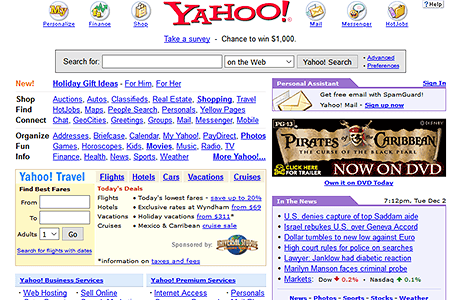
Yahoo began in 1994 as “Jerry and David’s Guide to the World Wide Web,” named after its creators, David Filo and Jerry Yang. The combination of internet search engine and directory of World Wide Web websites organized in a hierarchy of topic categories also offers other services including Yahoo Mail and Yahoo News.
MySpace launches (2003)
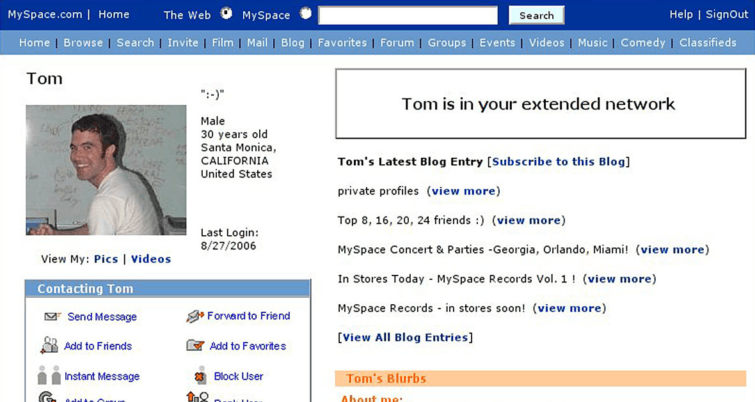
Remember many eons ago, back before Facebook changed/ruled the world, its forebear called MySpace? It was kind of addictive, wasn’t it? The social networking website launched on August 1, 2003.
Amazon launches (1995)

It’s kind of hard to believe that behemoth Amazon – which now sells just about everything on Earth except the Eiffel Tower, the Great Pyramid of Giza, and bottled water from the Fountain of Youth – started out in July 1995 as a humble online book store. But that little seed sprouted and grew like kudzu in unimaginable ways, and now Amazon co-owns James Bond. Jeff Bezos is the Man With the Golden Ambition if there ever was one.
Ebay launches (1995)

Do you remember AuctionWeb? No? Well, you probably know it better by its current incarnation: eBay. The online auction market went live a mere two months after Amazon did. The first item sold: a broken laser pointer. And despite the frequent misperception that Amazon owns eBay, the two are separate competitors.
Match.com goes live (1995)
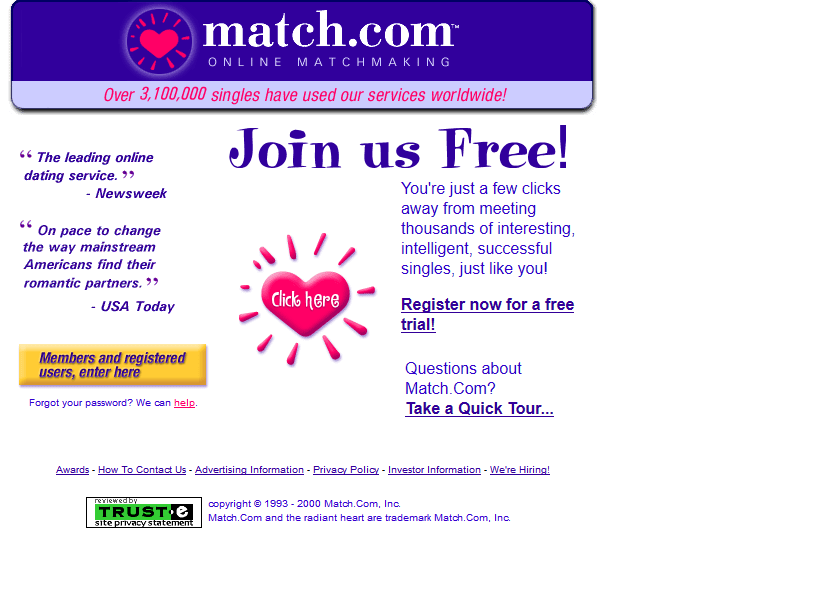
Match.com was the world’s first internet dating website when it debuted in 1995. In its wake, seemingly countless other websites and apps have promised to help us meet either Mr. or Mrs. Right – or Mr. or Mrs. Right Now.
Craigslist is introduced (1995)

Craigslist was created by American internet entrepreneur Craig Newmark as a classified advertisements website, and it quickly became a go-to marketplace for users to post their offers, wares, and services in categories like jobs, housing, for sale, items wanted, and more. It also included an “adult services” and personals section that was shut down in 2010.
Hotmail debuts (1996)

Nearly a decade before Gmail debuted and became the preeminent email service of choice for most of the world, Hotmail was the world’s first free web-based email provider. Hotmail would eventually get steamrolled by the Gmail goliath and would pack it in, but it lives on in Microsoft Outlook.
Napster debuts (1999)
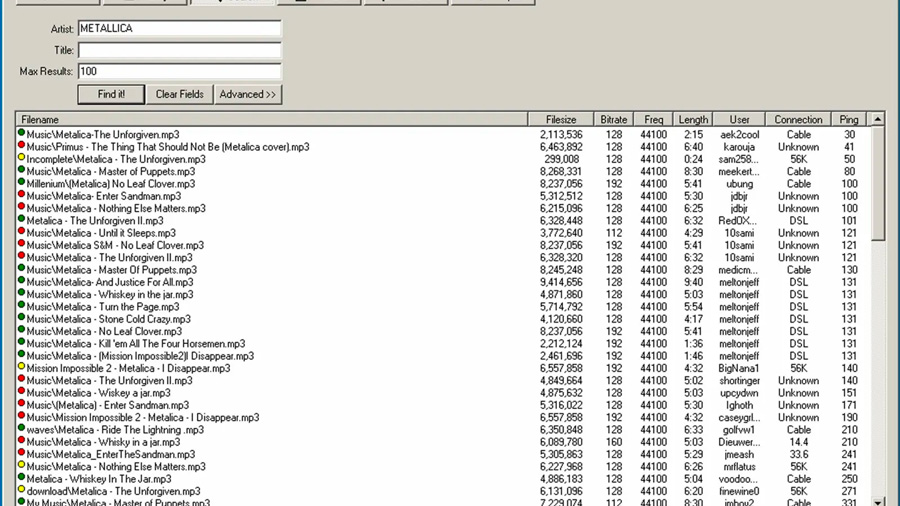
The original Napster reared its subversive head in 1999, when a teenager hit on the idea of creating a free file-sharing website to which users could upload MP3 copies of music illegally ripped from CDs and other sources. The website was, of course, a hit with some 80 million users and a cultural phenomenon – so much so that its creator got himself in some very hot legal water and drew the wrath of the millionaire musicians who weren’t benefiting from it financially. It also set in motion the eventual shift toward digital as the primary way consumers get their tunes. Now, in 2022, Napster is under different ownership and operates as a legal, pay-per-song music-download website.
Apple launches iTunes (2003)

Apple was eager to get in on the digital music revolution when it introduced iTunes to the world. In the beginning, it had 200,000 songs in its catalog available for purchase and download. There are now more than 26 million and counting.
Facebook launches (2004)
Today, Facebook is the cyber stage from which your friends and family present the most idealized versions of themselves and their lives, as well as debate current events to the point of mass hysteria…and it has some good uses, too. It began on February 4, 2004, as The Facebook, a directory for college students at the same schools to network. As it has grown and gone public to investors – and maybe even gotten a little too big for its britches – Facebook has not been without some intense controversies. But, like many large behemoths, it may be too big to fail.
Gmail debuts (2004)

In a time when many internet users were paying for email services and getting very little amounts of storage in which to keep their emails, when Google announced in 2004 that it would give those users an unbeatable deal, the electrical charge lit up cyberspace. Google would allow users to create email accounts free of charge and give them 1 GB of free storage. Now, Gmail is the largest and most popular email service online.
YouTube debuts (2005)
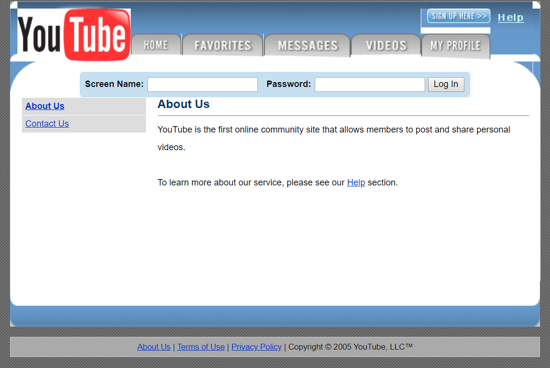
When Google acquired YouTube in 2006 for $1.65 billion in a stock-for-stock transaction, the video-sharing platform was already wildly popular just one year after it had launched. It was created by former PayPal employees, and the first video uploaded to the website on April 23, 2005, was an 18-second clip of one of its founders, Jawed Karim, in front of an elephant enclosure at the San Diego Zoo.
Netflix begins streaming online (2007)
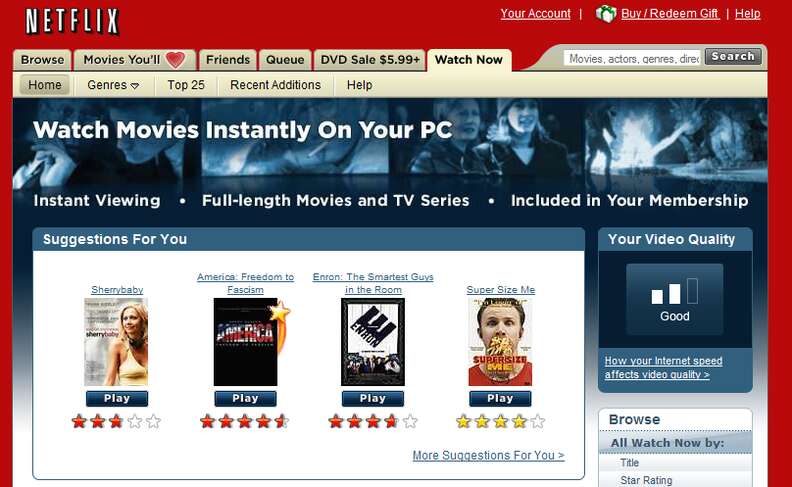
Netflix began in 1997 as a by-mail movie rental service, and the convenience it offered was one of the early death knells of brick-and-mortar video store chains like Blockbuster, Hollywood Video, and others. A decade later, its subscribers were able to start instantly watching TV shows and movies on their computers. And although that was a revolutionary development in the home entertainment space, watching entire movies on a small laptop or desktop computer monitor could be awkward at times. That’s why we were all overjoyed with the advent of streaming options like Roku, Amazon Fire TV, and gaming consoles. As Netflix increasingly added more existing content and developed more and better original shows and movies, and once we all made the move from our desks to our couches, we never looked back.
Wikipedia launches (2001)
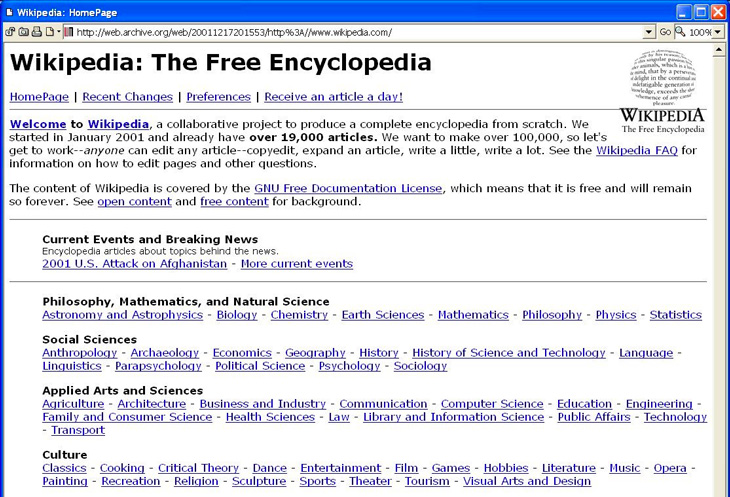
Launched on January 15, 2001 with its first edit, Wikipedia – you know, the thing that replaced encyclopedias and is absolutely, 100% reliable and error-free – is hosted and overseen by the Wikimedia Foundation, a non-profit organization that also has other online resources including Commons freely usable photos, Wikibooks free textbooks, and Wiktionary free dictionary (in case Merriam-Webster’s website isn’t reliable enough for you).
First tweet ever posted on Twitter (2006)

Credit for the first tweet ever posted on Twitter goes to Jack Dorsey, CEO of the service and one of its four creators. Published on March 21, 2006, it was short and oh so sweet: “just setting up my twttr.” On October 25, 2021, he sold it to a Malaysian buyer for $2.9 million as an NFT, or non-fungible token. That’s a lot of coin for no capitalizations.
The first picture ever posted on Instagram (2010)
Instagram CEO and co-founder Kevin Systrom uploaded the first picture ever posted to the app. It was a shot of a stray dog sitting near a taco stand in Mexico. Systrom captioned the photo as “test.” It was posted several months before Systrom’s idea for Instagram was shared with the public on October 6, 2010.
The first product ever sold on Amazon (1995)
It’s kind of hard to believe now that Amazon – in all its massive, omnipotent, world-dominating wonder – had humble beginnings as an online book seller, and that Jeff Bezos sold the books from an operation in his garage. And the first-ever product sold by Amazon was to Mr. John Wainwright, who purchased the book “Fluid Concepts And Creative Analogies: Computer Models Of The Fundamental Mechanisms Of Thought” by Douglas Hofstadter. And while we’re still not completely sure what a book like that would be about, it’s a small amazement to know that someone else did.
Greatest Viral Videos
Tillman the Skateboarding Bulldog (2007)
Tillman, the now dearly departed French bulldog, became a viral sensation when a YouTube video of him skateboarding appeared on the website.
“Right Up Our Alley” (2021)
Created in 2021 as a promotion for Bryant Lake Bowl & Theater in Minneapolis, Minnesota, this 87-second, jaw-dropping drone video – complete with a “The Big Lebowski” reference – was shot in one single take – no edits! That final crash is the stuff of nightmares for expensive equipment, though, isn’t it?
The September 21 Dance Guy
We can’t help but be caught up in the infectious joy and creativity that emanate from this viral video of the “September 21st guy,” Demi Adejuyigbe. Each year on, yep, September 21st, he releases a YouTube video highlighting worthy charities and raises funds for them through Actionnetwork.org.
Rick Astley, “Never Gonna Give You Up” music video
Who would’ve thunk it? This hit song, released in 1987 on Rick Astley’s debut album “Whenever You Need Somebody,” has somehow had a staying power that overshadows here-today-gone-tomorrow tracks by many of the English singer’s contemporaries. And even now, in April 2022, the song’s official music video, which was posted on October 25, 2009, has had 1,191,714,844 views. And we’re never gonna forget that it spawned the hilarious yet possibly most annoying internet prank: Rickrolling. Luckily, Astley has seemed to embrace his unexpected legacy as the subject of the gag.
Hot Ones Series
From the First We Feast channel on YouTube comes the series “Hot Ones,” with host Sean Evans interviewing a plethora of celebrities while they sample an array of increasingly volcanic hot sauces. One of the most popular entries features nice-guy actor Paul Rudd and has had 20,761,428 views as of this month.
BuzzFeed Unsolved Series
This documentary entertainment series was created in February 2016 by Ryan Bergara, who co-hosted with Shane Madej. It initially ran on BuzzFeed’s channel before being given its own, BuzzFeed Unsolved Network, due to its rising popularity and viewership. The show’s alternating thematic structure was unique in that each season focused on either “BuzzFeed Unsolved True Crime” or “BuzzFeed Unsolved Supernatural.” Two of the show’s most appealing elements were its comedic approach to frequently grim subject matter and the banter between Bergara and Madej. There were also spinoff specials, a retrospective, and five episodes of “BuzzFeed Unsolved Sports Conspiracies.” It ended in November 2021, as the hosts had departed BuzzFeed to form their own company, Watcher Entertainment, to produce unscripted digital series.
Greatest Websites
Homestar Runner

When the world was introduced to the Flash-animated website Homestar Runner at the dawn of the 21st Century, it discovered a mini-world of surreal humor and self-parody starring the title character. As the website’s popularity grew, so did the “Strong Bad Email” cartoons featuring the character Strong Bad. Other characters like Coach Z and The Cheat also became breakouts. The website is still active today, with cartoons, SBEs, games, and a store.
Space Jam 1996

It’s anybody’s guess whether the official movie website for “Space Jam” (1996) is still active as a joke, as an oversight, as nostalgia, or all of the above. All we know is that, from the standpoint of what’s possible today, it’s an epic masterpiece of cheap and amateurish design and functionality. But maybe we could cut it some slack since it was created only three years after the advent of the World Wide Web. Whatever the case may be, it’s definitely a time capsule!
FanFiction

This website, created in 1998, allows users to create free accounts and upload unofficial stories they’ve written based on celebrities and characters from popular culture in nine categories: anime/manga, books, cartoons, comic books, games, movies, plays/musicals, TV shows, and miscellaneous. With fan devotion to beloved entertainment properties evident in the creativity of the stories, it’s little wonder that the website remains as popular today as when it debuted 24 years ago.
Making Fiends

The quirky “Making Fiends” was created by animator Amy Winfrey in 2003 as a Flash-animated web series. The cartoon shorts, all clocking in at under five minutes each, featured villainous, sociopathic, narcissistic Vendetta and her army of “fiends” (which she creates from a book of recipes) being annoyed by – and attempting to eliminate – cheerful, naive Charlotte, co-starring a cast of equally oddball characters. It was licensed as a short-lived Nickelodeon series in 2004.
StumbleUpon

When Alice fell down the rabbit hole into Wonderland, she found herself in a surreal, frequently nightmarish world beyond imagination. If you think about it, the internet is a lot like Wonderland, except that we choose to enter it and know where we’re going. Well, sometimes we do. The rest of the time, there was StumbleUpon. This website, which was actually a discovery and advertisement engine, aggregated and pushed content to its users sourced from far and wide across the internet. The content was personalized to users’ tastes and interests. It was a great time waster. Although StumbleUpon officially shut down in 2018 and its users’ accounts transitioned to Mix.com, it’s still up and running in a different form.
Humans of New York

Photographer Brandon Stanton launched Humans of New York in September 2010 as a photoblog to chronicle the everyday lives of strangers on the streets of New York, with an initial goal of documenting 10,000 people. He soon began to interview them as well, including their quotes and stories with their portraits. The website’s popularity skyrocketed, even spinning off as two bestselling books. Stanton eventually expanded his palette with portraits and stories from over twenty different countries. With its continued worldwide following, the website proves that – in spite of our differences in ideologies and cultures – we may all be more alike than we might’ve ever imagined. We’re all just human.
WebCrawler

Created in January 1994, this search engine was first a desktop app before becoming a web version with its own database several months later. It had 4,000 websites in its database when it launched. It’s still active, although it dismantled its database and now just aggregates search results from Google and Yahoo.
Geocities

Launched in 1994 in the infancy of the internet, GeoCities was the first taste of web mastering and hosting for many users. It allowed them to create and publish websites for free. They could also browse websites, sorted by theme and interests, created by other users. Hyperlinks to the websites would be listed in “cities,” or categories named after real cities or regions, in order for users to easily find content relevant to their interests. GeoCities was acquired by Yahoo! in 2009 and later shut down in 2009.
Atlanta Time Machine

This website is a fascinating historical treasure trove of, as it states on its home page, “then-and-now photos of Atlanta through the decades, scores of old postcards, and miscellaneous ephemeral stuff like old advertising for nightclubs, bars, and restaurants.” It’s a look back at the city’s days of auld lang syne and an engrossing visual documentation of how much things and places can change. The website hasn’t been updated since 2014, the year that its creator, Greg Germani, was tragically and critically injured in a hit-and-run accident.
Internet Archive
/cdn.vox-cdn.com/uploads/chorus_image/image/47494933/Screen_Shot_2015-10-22_at_11.57.31_AM.0.0.png)
Internet Archive may be one of the most amazing websites on the internet, if we do say so ourselves. A 501(c)(3) non-profit, it’s a digital library of websites and other cultural artifacts in digital form, all available for free to users. It was founded in 1996 with the mission to archive the internet, which was still in relative infancy but growing in use. Today, through integration with the Wayback Machine, it has more than 25 years of web history, and it partners with over 950 libraries and other entities to identify important and historical web pages. It provides digital versions of web pages, books and texts, audio and video recordings, photos, and software programs.
Nice One Dad

If you were ever mildly amused but mostly embarrassed by your father’s lame jokes when you were growing up, here’s a website for you to relive those days from a relatively safe distance. It’s a simple premise: jokes and punchlines, advancing from one to the next with a click of a mouse. But keep in mind that it can be mildly addictive, so if you keep clicking and suffer traumatic flashbacks, don’t blame us!
Urban Dictionary
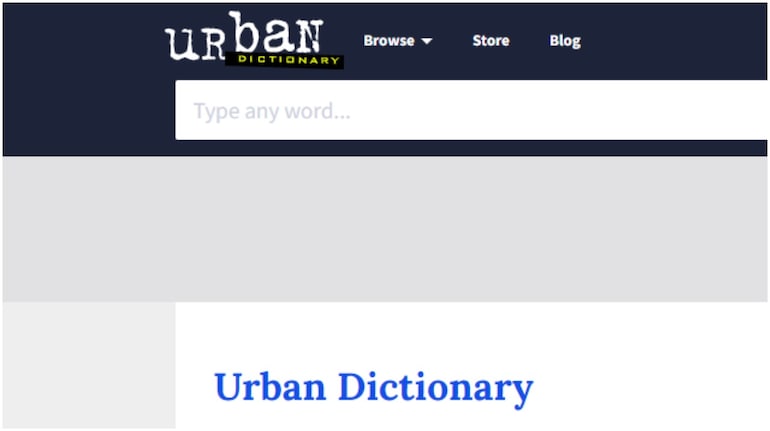
Created by Aaron Peckham in 1999 as a parody of what he felt was the stuffiness and self-seriousness of standard dictionaries, Urban Dictionary is a crowdsourced online dictionary that began including solely slang words and phrases. As its popularity and use grew, it incorporated slightly less outrageous – though not less hilarious – words, events, and phrases. Yeah, the words and definitions can be crude, raunchy, and politically incorrect. But that’s the beauty of not being Merriam-Webster, right?
TikTok
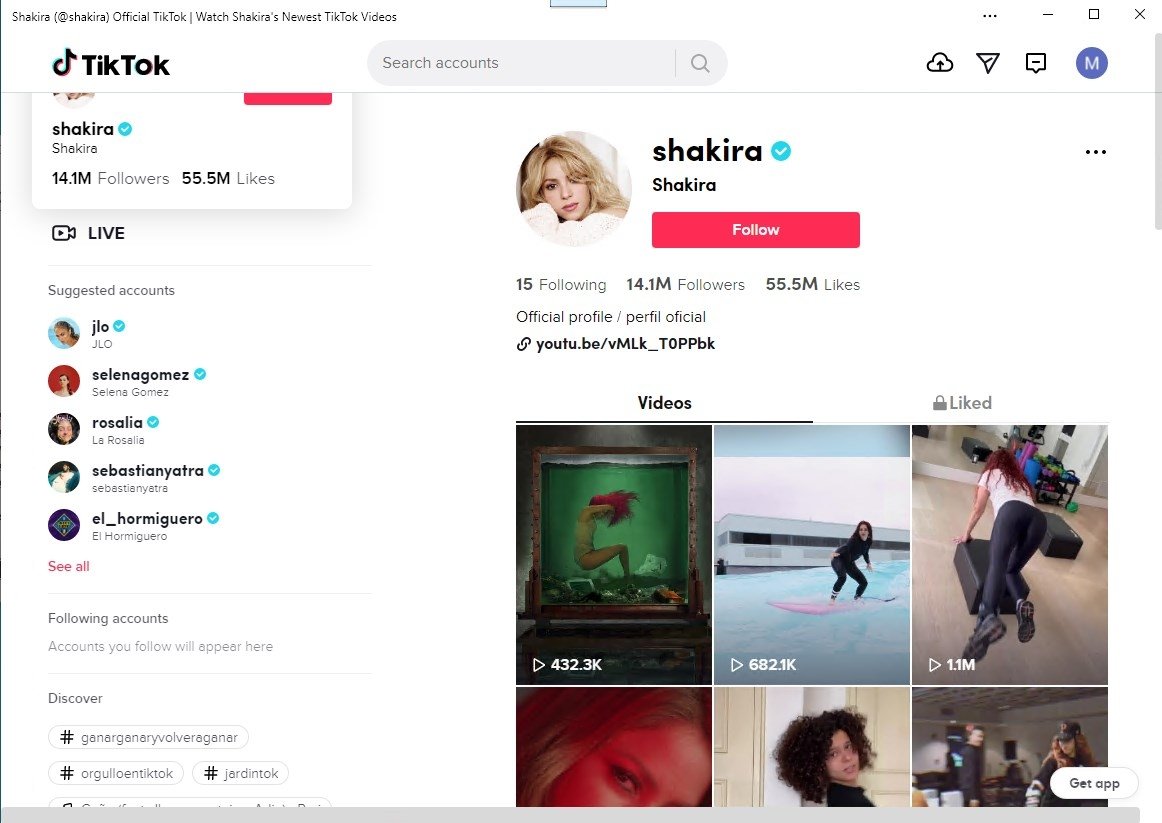
Launched in 2017, this Chinese-owned networking app features user-generated short-form videos of pranks, stunts, tricks, jokes, dancing, and entertainment. The videos range in duration from fifteen seconds to ten minutes. Its demographic is primarily younger users, with 41% of them between the ages of 16 and 24. And TikTok’s massive popularity has served as a kind of virtual stage for its users, including unsigned and independent bands and singers, to share their creativity to worldwide audiences. It has also given rise to viral trends, internet celebrities, influencers, “challenges,” and marketing.
NORAD’s Santa Tracker

Every December – when visions of sugarplums, the latest iPhone, and mini Ferraris dance in children’s heads – it stands to reason that the little tykes will want to prove to Santa that they’ve been good all year, even if he’s been watching and has them inked onto his naughty list. Still, that probably won’t stop the kiddos from trying to get the drop on Saint Nick before his arrival in their cul-de-sacs. What better and more reliable way to do it than with the help of the North American Aerospace Defense Command’s Santa Tracker website? Every year on December 1st, NORAD’s placeholder website goes live so everyone can spy on ol’ Kris Kringle. Turnabout is fair play, Santa.
Ready to Become a Legend on the Web?
Are you ready to make your unique mark on the web and become a legend? You can start by registering a domain name with DreamHost!

Your Great Idea Starts with a Domain Name
Don’t let someone else register your URL. Search DreamHost’s 400+ TLDs to find the perfect fit for your website.
Master Your DomainThe post 50 of the Greatest Things Ever Published on The Web appeared first on DreamHost Blog.
]]>The post 5 Reasons Why You Need More Than One Domain appeared first on DreamHost Blog.
]]>But like Lay’s potato chips, I bet you can’t have just one.
Purchasing multiple domains for your company can increase the visibility of your business and protect your brand from hungry competitors.
And you don’t need to get started! In fact, there are several good reasons to purchase more than one for your — even if it means coughing up some extra cash up front. In this article, I’ll break down exactly why it’s a solid idea to have multiple domains and how this can impact your business.
Once you pop, the domains don’t stop.
1. People Can’t Spell
It happens all the time. Humans make mistakes, especially when putting words on paper and URLs into browsers. This is why it is a great idea to consider snatching up some variations on your primary domain.
For instance, Google bought Googel.com and Gooogle.com since these are common mistakes people can make when typing in their browser’s address bar.
When you allow for human error by picking up additional domains, you can capture spelling-challenged users instead of losing them to the internet void — or worse, a competitor’s website.
If you already have a domain but are unsure if you should snatch up some misspelled variations, data can help!
Go to the Google Search Console, log into your Google account, and then click on your website property. Click on the Search Traffic drop-down on the left and then Search Analytics. From here, you can check on search queries people have used to find your site, making it easy to keep tabs on which search terms, if any, may be misspelled. If you happen to find a recurring misspelled term that directly relates to your primary domain, you might want to consider buying that domain name and redirecting it to your main landing page.
2. You Need to Protect Your Brand
Purchasing multiple domains for your business site can be a huge aid in protecting and strengthening your brand in a few key ways.
Stop Copycats
Keep competitors from snatching up a similar domain and causing confusion for your users. You don’t want business copycats directing traffic away from you.
Rebrand Like a Pro
If your business used to have a different name, it could be a good idea to have domains for both the old name and the new one to get customers to the right homepage. The same goes for if you want to change the name of your brand. Buy a new domain and — once the new website is built and ready — redirect the old domain to the new one.
Consider Consumers
Depending on what goods and/or services your business provides, it might be a good idea to register an additional domain name that appropriately describes what vertical your business is in — think JoeShmoeCupcakes.com versus simply JoeShmoe.com.
And remember, people might not always refer to your brand by the official name. Here’s a real-world example. Coca-Cola is an official company name, and the brand’s official website is Coca-Cola.com. But many people all over the world commonly refer to the soda giant as “Coke.” That’s why if you type Coke.com in your browser’s search bar, it redirects appropriately.
Using specifically descriptive domain names makes it easier for a potential customer to find you — and helps with search engine optimization (more on that in a sec).
Make Use of New TLDs
Something else to consider is jumping on the new top-level domain (TLD) train. New generic top-level domains (ngTLDs) — like .xyz or .store — can present a new opportunity for your business.
Let’s say you sell original art prints and operate a website called, CindysPhotography.com. Having a .com is absolutely necessary, and it may be wise to also snatch up a .net (depending on your business). But purchasing an additional ngTLD like CindysPhotography.art can open you up to a dedicated collection of users looking specifically for products in your business vertical. You could also acquire CindysPhotography.store and link it directly to the e-commerce portion of your website in order to drive more traffic.
Buying these types of domains can make your business stand out in search results and highlight what differentiates you from the competition.

Protect Your Brand Today
Don’t let someone else register your URL. Search DreamHost’s 400+ TLDs and secure your brand online.
Master Your Domain3. You Want to Boost Search Engine Optimization
As we’ve already hinted, having more than one domain for your business can improve your page rankings in search engine results. It is crucial to note that buying up multiple domain names for your business should be redirected to your primary landing page using what is called a 301 redirect.
According to SEO.com, when creating a Robots.txt file and an XML sitemap so that search engines can index your site more easily, including 301 redirects from multiple purchased domains to a singular destination makes it even easier for your site to be indexed properly. Google will not penalize you for duplicate content with this redirect, and it is an easy thing to implement through your domain registrar or site-builder (speaking of, have you heard about our WordPress website builder?).
However you build your website, redirecting domains is generally a simple task. Simply search for a domain redirect option in your site builder’s interface or contact the support team.
4. You Want to Set Up Promotions and Special Offers
Using multiple domains for promotional purposes can be a great way to generate brand buzz and drive traffic to your website. You simply register a new domain related to the event and create a specific landing page for the promotion.
Let’s get back to the potato chips we were talking about earlier.
Say your business sells crispy, delicious potato chips, and your company website is SallysChips.com. Hypothetically speaking, you just came out with a brand new wasabi-flavored chip (why not?) and want to promote it.
First, you’d create a snazzy new landing page with mouthwatering pictures, compelling content to convince readers that this is, in fact, a good idea, and a link to order online. Then you could pick up the domain SallysWasabiChips.com instead of using SallysChips.com/wasabi. Why? Because the new domain is easier to remember for users and simpler to advertise.
If you have multiple promotional TLDs redirected and properly represented in the sitemap file, search engines will index these domains appropriately, and your page rankings can increase as a result.
However, it is important to note that if you do purchase a domain for a temporary product or service promotion, once that promotion has ended, you should disable that domain, hide the landing page, and update the sitemap so as to not saturate search engine results with outdated pages.
5. You Want to Expand Into New Markets
It is never too early to start thinking about the geographical expansion of your business, and multiple domains for your business can aid in this endeavor.
In fact, if you operate an online business that serves people outside of your home country, investing in country-specific TLDs is a must.
To achieve the best results in international SEO, you will need other country domains that lead to your site. For instance, if you own an online pottery store based out of New York City but sell to Europe and Canada, having NYCPottery.co.uk and NYCPottery.ca, in addition to your primary domain, will give you a big advantage.
As soon as expanding on an international level becomes a relevant venture for your business, acquiring multiple country-code domains is a must.
Is This Strategy Right For Your Business?
While having multiple domains for your business is very beneficial in many cases (we’ve obviously just given you five compelling reasons), it is important to note that not all businesses need more than one domain.
For example, if you own a single brick-and-mortar store, then it might not be a good idea to own multiple domains since you don’t want to confuse customers. When it comes to small businesses with single locations, a simple and specific domain name is the way to go.
Let’s say you have a bookstore in Austin, Texas, called Bobby’s Books, and you buy the domain BobbysBooksAustin.com. Purchasing additional domains like BobbysBooks.com, BobbysAustinBooks.com, and BobbysBooksinAustin.com and having them all redirect to the main website is probably unnecessary.
Dominate Your Domain Strategy
Do you feel ready to start buying up domains for your new website? DreamHost makes it simple and easy to find the best domains for you with more than 400 available TLDs.

Domain Deals for a Limited Time
Secure your new domain name(s) before someone else does! Click here get a discounted domain for a limited time!
Secure Yours NowThe post 5 Reasons Why You Need More Than One Domain appeared first on DreamHost Blog.
]]>The post A Beginner’s Guide to Domain Name Registration appeared first on DreamHost Blog.
]]>Since the first domain was registered 30 years ago, the internet has expanded at an astounding rate. In fact, by the end of 2015, there were more than 314 million active domain names on the internet with a year-to-year growth of 9%. That means that each and every day, people around the world are registering domain names and claiming a piece of internet real estate.
So what exactly are domains, anyway? And why are they so important?
Domains — a.k.a. domain names — are how we organize all of the websites and pages everyone visits on the web. The Domain Name System, or DNS, is the universal naming system for assigning addresses to web pages and web servers. Think of the DNS as one large phone book. Essentially, domain names are what we type into our web browser to visit a specific site. Without domain names, the internet would basically be useless. There, we said it.
In this article, we’ll cover what domains are, how they work, and how to register your very own online home. But first, let’s take a closer look at the hierarchy and formatting of domains.

What Is Domain Registration?
It’s the beginning of your big idea! Search DreamHost’s 400+ TLDs to find the perfect URL for your website.
Master Your DomainHow Domains Are Formatted
The first rule of domain fight club? Put that left-to-right junk you learned in English class to the side. The hierarchy of domain names is organized from right to left.
Let’s take a look at some domain names:
- DreamHost.com
- Wikipedia.org
- UCLA.edu
- Gamesindustry.biz
- Sourceforge.net
The general descriptors are called top-level domains (TLDs). TLDs come at the end of the domain name — think “.com,” “.org,” “.net”.
The specific descriptors to the left of the TLDs are the second-level domains (SLDs) — like “google,” “wikipedia,” “twitter,” etc.
To the left of the SLD is the machine name (e.g. “www.”).
Each level of the domain is separated by a period — the eponymous “dot.” So, in the “google.com” example, “google” is the SLD, and “.com” is the TLD. Most American web servers use three-letter TLDs, like “.com” or “.net,” while many other countries use two-letter or two-letter combination country-code TLDs (ccTLDs), like “.ca” for Canada or “.co.uk.”
In more recent years, new generic top-level domains (ngTLDs) were introduced, which has opened the internet to a new world of possibilities for TLDs. These can be customized specifically for your business, so you could have a domain name that ends in “.marketing” or “.store.” But more on that later.
One thing that is important to note is a domain name is not the same thing as a URL. The truth is, the domain name is merely a part of the URL, which is the larger, more specific internet address that may contain a specific page address, a folder name, a machine name, and even a protocol language.
Here are some examples of URLs so you can see the difference (the domain names are bolded):
- https://www.dreamhost.com/hosting/wordpress/
- https://en.wikipedia.org/wiki/Domain_name
- http://www.ucla.edu/about/
- http://www.gamesindustry.biz/media-and-marketing
- https://sourceforge.net/directory/business-enterprise/os:mac/
House Rules
Domains have a particular set of formatting rules that determine whether or not a domain name is valid. Here’s a quick overview.
- Domains are not case-sensitive. Typing “Google.com” as opposed to “google.com” into your web browser will yield the same result.
- There are no spaces allowed in domain names. Oftentimes a dash may be used to differentiate certain words in a SLD for the purpose of clarity. For instance, say you run a business that helps people find merchandise resellers. The domain “who-resells.com” is way easier to understand (and more appropriate) than, ahem, “whoresells.com,” am I right? There isn’t any sufficient evidence that search engines, like Google, penalize sites in the page rankings due to dashes in the domain name. However, it may be more difficult for users to find your site if there are dashes in the domain name, so make sure you only use a dash if it helps with clarity.
- While letters, numbers, and dashes are allowed in a domain name, special characters (?, &, !, etc.) are typically not allowed.
- SLDs must be at least two characters long and have a 63-character limit. TLDs do not count towards this limit.
Although domains may initially seem complex, it’s pretty simple when you break down the language of the internet. Now, let’s delve into exactly how domains work.
Where Do Domains Come From?
Time for the birds-and-bees talk already?! They grow up so fast.
Let’s get technical for a minute. As discussed above, a domain name uses an easy-for-humans-to-remember string of letters or numbers (like dreamhost.com) to point to something specific on the internet, typically a webpage or web server.
So, what happens when you actually enter a domain into your web browser’s address bar?
As a user, you are directed to a specific web server’s IP address, which is translated in your browser, using the DNS, into what we recognize as the domain name format. IP addresses consist of four sets of numbers (values ranging from zero to 255) separated by dots (e.g. 111.111.111.111). The DNS translates the IP address into a more easily graspable language; after all, we humans are much better at remembering “Facebook.com” rather than “69.63.191.255.”
So, where do domains actually come from? Well, the primary governing authority on the Domain Name System is Internet Corporation for Assigned Names and Numbers (ICANN). ICANN was formed in 1998 in order to oversee and organize the maintenance and management of the DNS.
This organization plays a very important role in the inner workings of the internet because, without them, we wouldn’t have a streamlined, universal way of communication between computers across the globe. Here’s a simple breakdown of what they do, according to ICANN themselves:
- They are responsible for coordinating the names and numbers that relate to internet addresses. They do not actually register domain names with the exception of “.int,” which is used for intergovernmental agencies with international treaties.
- They work to ensure the security, stability, and interoperability of the internet through creating fair policies and through operation of the DNS.
- They allocate IP addresses to five Regional Internet Registries, or RIRs, and in-line with IETF decisions. The RIRs then allocate addresses to ISPs (Internet Service Providers) who sub-allocate to networks and individual users.
In other words, ICANN supervises the DNS and offers the opportunities necessary to accommodate for an ever-expanding internet with millions and millions of domains. ICANN delegates the responsibility of maintaining certain TLDs to what are called registry operators.
Registry operators are then tasked with maintaining a registry of active domains under their TLD.
So for example, Verisign is the registry operator that maintains the .com and .net TLDs. From there, a registrar, accredited by either ICANN or a registry operator, sells and distributes domain names to internet users. Nowadays, it is super common to find hosting companies — like DreamHost — that double as a registrar, so you can register a domain and pay for web hosting in one fell swoop.

Want to Learn More About Domain Name Rules?
We’ve got content for that! Subscribe to our monthly newsletter so you never miss an article!
Sign Me UpDo You Need a Domain Name?
There are three important reasons why you absolutely should want your own domain:
- Owning Your Domain — For example, if you wanted the domain “jingleheimer.com,” you would have to register that domain name through a registrar. Some companies, like WordPress.com, offer free website services that do not include a domain registration. So in that case, your site would appear as jingleheimer.wordpress.com (read more about WordPress.com naming conventions here). We definitely get that for some people, a free option is the best budget choice. But if you’re looking to build a brand or rise to the top of search engine results, you’ll need your own domain.
- Having a Permanent Web Address — Once you purchase your domain name, that domain is reserved. You own that domain name until you choose to let it expire. So as long as you keep the domain registered (it’s easy to set up auto-renewal), it can be your home on the internet forever.
- Registering a Domain is Cheap — Registering a brand new domain name averages between $10 and $15 a year. That is a small price to pay for owning your very own address on the internet. DreamHost offers free domain registration for the first year when you sign up for the annual shared hosting plan. That knocks out your web hosting and domain registration with one (digital) stone.
Registering your own domain name is the best way to own your content on the internet. It looks more professional, and registering your own domain is simple, affordable and gives your content a permanent online home.
Choosing the Right Domain Name
Once you make the decision to pour a digital foundation on the internet, it’s important that you choose the right domain name for your site. Here are several things to keep in mind as you pick your domain.
Remember the Power of .Com
There are hundreds of TLDs to choose from, but perhaps the best and most effective is .com. The reason is simple: exposure. According to a study performed by marketing firm Searchmetrics, 75% of the 100 million web links analyzed directed to a .com TLD. Love it or hate it, .com is simply the most used and recognized TLD on the web.
Unfortunately, sometimes the .com that you want won’t be available, leaving you to settle for a .net, .org or .info. In that case, it might be a good idea to rethink the name of your SLD.
Another option to consider is registering a new generic TLD, like a “.social” or a “.xyz.” Although these are still relatively new in the world of web building, ngTLDs have quickly been increasing in popularity and offer small businesses a chance to cultivate their own online community (more on this later).
Of course, if you work in a government agency or educational organization, it would be best to go with a .gov or .edu, respectively. Also, if you have a business that markets specifically to a certain geographic area, it would be a good idea to use a ccTLD, like .co.uk for England or .jp for Japan.
Consider the Length
Remember, you’re limited to 63 characters. But this isn’t Twitter. You don’t want to use up all your characters; it will make your domain name too difficult to remember — and way too time-consuming for your would-be visitors to type into a browser.
But this is a double-edged sword. Short domain names with only a few characters can be just as difficult to remember as long ones. Plus, it’s easier to confuse just a few letters with other short domains.
A good rule of thumb? Keep it under 15 characters and stick to three words or less. That way, your domain will be memorable and easy to type.
Think About Keywords
Make room for a keyword that will be easy to remember and may even support or reinforce your search engine optimization efforts (we’ll talk more about SEO later). Considering localization is important too. If you have a site that is promoting a local business or community, using regional keywords or phrases is a solid method for attracting users in your area (for example, basketweavers.nyc for all things related to basket weaving in New York City).
Keep It Simple
Avoid numbers, words with more than two syllables, or inside jokes unless it directly relates to or is crucial for your business or brand. When keywords or phrases become too specific, the domain can become hard to remember. Also, make sure your domain name can’t be construed as something that you didn’t intend (like that “who-resells.com” example earlier).
Research Your Domain
If you feel as though you’ve picked the right domain name for your site, it’s time to make sure your potential domain is legally and marketably viable. Make sure your domain choice isn’t infringing on any trademarks and that there isn’t another website that is already operating under that name. It is important that you protect yourself legally, but it is also worth doing this to make sure your business or brand name doesn’t conflict with any existing businesses. Remember, you want to stand out from the crowd, not get lost in it.
Don’t Forget About Privacy
Lastly, it’s important to think about your privacy when registering a domain. Domain privacy, commonly referred to as WHOIS protection, hides your personal information from the public WHOIS database when you register a domain.
Why would you want your data hidden? Well, when you register a domain, your personal details (like your name and home address) are considered public information. That means that anybody could search your domain in the WHOIS database and find out who you are and where you live.
That’s why DreamHost includes free domain privacy protection when you register a domain with us. Sketchy weirdos shouldn’t have access to your name and address — no matter what.
Registering Your Domain
Once you are ready to own a new domain, it is time to register it. There are many different ways to register a new domain name. As mentioned previously, there are tons of domain registrars all over the web from which you can buy a domain.
Cost-wise, most registrars will run you anywhere from a promotional first-year fee of $0 to $5 or a straight, annual fee in the neighborhood of $10 to $20 and up. You will need either a debit/credit card or a PayPal account to pay for the domain. Paying for a domain will allow you to claim and acquire that domain name immediately upon application. Before we dive into the process of registering a new domain, it is important to understand the difference between domain registration and web hosting.
While a domain is simply the address where users can find your site on the internet, web hosting is the service that essentially provides the “housing” for your address. An address means nothing if you pull up to an empty lot. You need both a domain as well as hosting in order to run a fully functional website. That’s why we think it’s a really good idea (and bargain) to keep web hosting and domain registrations under one roof.
When you register with DreamHost, for instance, you get a pretty sweet set of benefits.
- Get free a domain when you buy a hosting plan.
- Free domain privacy protection to hide your personal info from the public WHOIS database.
- Ability to purchase a broader range of domain extensions, like .com, .net, .co, .uk and .io.
- Easily manage your DNS server info and records.
- Protect your domain from being hijacked by scammers.
- Set up subdomains, like news.yoursite.com or blog.yoursite.com.
So let’s take a look at how to easily register your domain through DreamHost:
- Visit dreamhost.com/domains. This is our domain registration portal, specially designed to help you find the right domain name for your website.
- From here, enter the domain name you want to register into the search bar at the top of the page and press the magnifying glass button.
- Look through the Featured, Popular, and Suggested domain name sections of the page to find the domain name you’d like to register. Each available domain name will be accompanied by a button that shows how much the registration will cost you annually.
- Choose the domain you want, enter your email and password in order to create your account with DreamHost, and then click Continue.
- From here, you can complete the registration and process the payment. The steps are easy to follow. Keep in mind, domain registration is completely free for the first year when you sign up for a shared hosting plan; available TLDs change monthly.
If you are starting a business website, it’s important to note that, while not necessary, it may be a good idea to purchase several domains that redirect to your desired domain name. If you have a .com website, snatching up domains with the same SLD but TLDs such as .net, .org, .info, etc. can drive more end users to your site. You can also do this with various misspellings as well. For instance, “googel.com” and “gogole.com” redirect to the real Google.
Getting a domain is simple, easy, and necessary for establishing your place on the web. To learn more about registering domain names, check out our Domain Registration Overview.
New Generic Top-Level Domains
As mentioned earlier, the internet has seen a new generation of top-level domains known as “new generic TLDs” or simply, ngTLDs. These are top-level domains that have been introduced by ICANN in recent years and don’t fit the same mold as a .com or .net. In October of 2013, ICANN announced that the first batch of ngTLDs was delegated into the internet’s root zone (the top of the DNS hierarchy which contains all of the delegations for top-level domains).
The very first ngTLD was .guru, and it was made available to the public in February of 2014. Following the success of .guru, a number of ngTLDs like .club and .link were introduced and were welcomed by new domain buyers. In June of 2014, .xyz was introduced, and two years later, more than six million domains were registered using this ngTLD.
So why is all this important?
Well, while .com is still the most popular top-level domain on the web, the internet is continuing to see a greater interest in these alternative ngTLDs. This is partly due to the fact that a great majority of .com domains have already been taken, and pricing for certain highly desired .com domains have become more competitive and therefore more expensive to own.
While it’s probably too early to tell precisely how ngTLDs will affect the future of how people approach creating websites, there has been a huge uptick in recent years. Five years into the future, we may see a significant influx of new sites popping up with ngTLDs that are completely dominating their respective markets.
How Domain Names Impact Your Business
The right domain name can impact a website’s traffic and overall brand image for a business. Many might attribute this to a domain’s impact on SEO.
But how can a domain name affect SEO?
Well, truth be told, a domain doesn’t have too much of an effect on SEO. There are roughly 200 ranking factors in Google’s algorithm, and the domain name is only one of them. While this implies that a domain name would have very little to no effect on the site’s SEO, there are other ways a well-chosen domain can help. Here are three primary ways it can. Think of them as “the three Rs.”
1. Reputation
If you have a solid domain name that is properly spelled and relevant to your business or vertical, your reputation and web authority will definitely increase. Additionally, acquiring all the possible counterparts of your domain name, such as variants of TLDs and SLD domain misspellings, will help protect you from possible reputation damage.
2. Relevancy
Although including a keyword in your SLD isn’t a guaranteed SEO boon, picking a relevant domain will make it easier to get users to click on your links. They’ll know what they’re getting into!
3. Reach
Know your audience and register your domain accordingly. Having a domain name that targets a particular community or location can boost your site visits and interactions. A domain that speaks directly to the people you are targeting (basketweavers.nyc) can make people more inclined to visit your site.
The “Dot” to Our “Com”
Have we hammered it home, yet? Domains are important, not only because they are a crucial part of the overall construct of the internet, but because they are the first step on your journey to building an online presence.
Not to get emotional or anything, but we think that’s a pretty big deal.
So are you ready to start your website? Here at DreamHost, it’s super easy to find the perfect TLD for your website. Click over to our Domain Name Search to see for yourself.
The post A Beginner’s Guide to Domain Name Registration appeared first on DreamHost Blog.
]]>